Chemistry and Chemists № 1 2024
Journal of Chemists-Enthusiasts
| Content | Chemistry experiments - video | Physics experiments - video | Home Page - Chemistry and Chemists |
|
Chemistry and Chemists № 1 2024 Journal of Chemists-Enthusiasts |
Vegetable oil, ethanol and water (formation of emulsion) - part 5, 6 V.M. Viter |
|
Having noticed a mistake in the text, allocate it and press Ctrl-Enter
Castor oil, ethanol and water (oil dissolves in ethyl alcohol) - part 5
It is believed that sunflower oil does not dissolve in ethyl alcohol. I checked this statement (fortunately, ethyl alcohol and sunflower oil are readily available). When I added sunflower oil to ethanol, no dissolution was visually observed. However, conclusions cannot be drawn based on visual observations alone. After shaking and separating the two liquids, I took a sample of the alcohol and added it to water. As a result, a white emulsion was formed. Thus, part of the sunflower oil dissolved in ethanol. When this solution was mixed with excess water, the alcohol went into the aqueous phase, and the oil formed small droplets dispersed in the water. Such a system is known as an oil-in-water emulsion.
Касторовое масло, этанол и вода (масло растворяется в этиловом спирте) Of course, sunflower oil is not the only oil in the world and not the only readily available oil. I remembered another fact I had read many times: castor oil is soluble in ethanol! Castor oil is obtained by cold pressing the beans (seeds) of the castor oil plant (Ricinus communis, the castor bean). In addition to oil, seeds of Ricinus communis also contain proteins, including ricin, which is extremely toxic to humans. Castor oil is used in the chemical, paint varnish and other industries. For a long time, castor oil was one of the best lubricating oils, but then it was replaced by synthetic oils. Castor oil was also used to care for leather clothing and shoes. Ricin, in turn, is a chemical warfare agent (due to its high toxicity and availability). It has also been studied as a possible insecticide. Ricin was not used as a poisonous substance on the battlefield; however, this protein was used by the kgb of ussr and the intelligence services of satellite countries to kill dissidents [1]. Despite the toxicity of ricin, refined castor oil is used in medicine as a strong laxative. Of course, for this purpose, the ricin must be completely removed from the oil. Castor bean is often grown in flower beds and gardens since this plant has large, beautiful leaves [2]. I picked castor beans several times to photograph. Twice, I even chewed the castor bean seed, but I did NOT swallow it - there were no consequences. A pharmacologist I know told me that his university classmate not only chewed castor seeds but ate them. Fortunately, she did not get poisoned; her reckless act ended in diarrhoea (diarrhea). I think castor oil caused a laxative effect and saved the girl from fatal ricin poisoning.  Ricinus communis / the castor bean / castor oil plant In any case, I strongly do NOT recommend that readers repeat such experiments. Stupid death is not "cool" at all. Let us return to castor oil and ethyl alcohol. I planned to conduct two experiments. First, pour alcohol into a test tube and add some castor oil to it. Stir and check if the oil dissolves. If the oil dissolves in the alcohol, I will add another portion of castor oil and stir. Then, I will add the next portion, and so on, until the oil stops dissolving in alcohol. After this, the second experiment will be. I will add a small portion of the solution of castor oil in alcohol to a glass with water and mix. A white emulsion should form, as is the case with the solution of sunflower oil. The alcohol will go into an aqueous solution, and the castor oil should form small droplets dispersed throughout the liquid. The solubility of castor oil in alcohol can probably be found in reference books since this oil is an essential technical product. But I decided to check this fact experimentally. I hoped, at least, a few drops of castor oil would dissolve in the alcohol. I poured 10 ml of ethyl alcohol into a wide test tube. I began adding castor oil to the alcohol in small portions. First, I added 1 ml. The oil sank to the bottom in the form of drops and streams. I stirred the liquids. Castor oil has completely dissolved. A clear and colourless solution was formed. Thus, 1 volume of castor oil was dissolved in 10 volumes of alcohol. After this, I should have proceeded to the second experiment to obtain an oil-in-water emulsion, but I did not. I was inspired by the initial success and decided to add the oil to the alcohol until the castor oil stopped dissolving. I added another 1 ml of castor oil to the test tube and mixed the content. A clear and colourless solution was formed. Then, I repeated the described procedure several times; the result was the same. At first, when stirred, the liquid became cloudy, but then the oil completely dissolved, forming a clear solution. In total, I added 7 ml of castor oil to 10 ml of ethanol. The result was a homogeneous solution. It turned out that the solubility of castor oil in ethanol is either unlimited or very high. To determine if there is a solubility limitation, additional castor oil could have been added. However, I stopped adding new portions of oil to alcohol. The fact is that the resulting solution was intended to be used for the second experiment. The purpose of the second experiment is to obtain an oil-in-water emulsion. If our solution contains a lot of oil and little alcohol, most likely, the liquid will behave like pure castor oil. As a result, after mixing this solution with water, the liquids will simply separate; no emulsion will be formed. I thought I had ALREADY added "too much" castor oil to the alcohol. So, the solution prepared from 7 ml of castor oil and 10 ml of ethanol was in a test tube. I pipetted 1 ml of the solution and added it to a glass with 200 ml of distilled water, then mixed the contents with a glass rod. After mixing, the liquids quickly separated. Below, there was a layer of water that remained transparent and colourless - an oil-in-water emulsion did not form. There was a layer of castor oil on top. Most of the oil turned white and lost its transparency. The white colour of the liquid is due to the formation of a water-in-oil emulsion. This emulsion also adhered to the glass rod. Thus, two layers of liquid formed in the glass. Below was water (more precisely, a solution of ethanol in water), and above was an emulsion of water in oil. When standing, the top layer became discoloured, indicating that the emulsion had broken down. Consequently, castor oil was on top, and water (a weak ethanol solution) was at the bottom. When I finished experimenting and started writing the article, I realized my mistakes. The first and second experiments should not have been combined. During the first experiment, I should have added castor oil to the alcohol until the oil stopped dissolving or until it became evident that the liquids could be mixed in all proportions (a property known as miscibility). Alternatively, after adding 10 ml of ethanol to 7 ml of oil, I should have conducted the reverse experiment by pouring castor oil into another test tube and gradually adding ethanol to it. For the second experiment, it should have been necessary to pour 5-10 ml of alcohol into a test tube, add 1-2 drops of castor oil (no more), mix the liquids, and then use this solution to obtain an emulsion. What is the advantage of the experiments described in this article? They are easy to repeat. In this case, you can change the experimental conditions. Unfortunately, this does not always happen. For example, if you are working with a rare or unique sample, and this sample is consumed during the experiment, then there will be no second attempt. Or, when you conduct a dangerous experiment with a gross violation of safety regulations, you may not live to carry out a repeat experiment... Of course, our experiments with sunflower or castor oil are not dangerous; however, chemists often have to deal with much less "kind" substances. __________________________________________________ 1 Readers interested in this topic can independently find information about the murder of the Bulgarian writer and journalist Georgi Markov in 1978. The murder weapon was an umbrella, which injected a capsule with a lethal dose of ricin into the writer's body. Putin, with his "novichok" and "tea with polonium," did not come up with anything new. He is a cowardly, evil dwarf - this is how he will be remembered after death. On the one hand, the author should not have touched on this topic in a chemical article. I understand perfectly well that a chemical article should not become a political treatise. On the other hand, a full-scale military invasion of my country is happening right now. Hundreds of thousands of our people were killed. Every day, women, children and elderly people die. The killers are the same. They poisoned Markov, and they are destroying us with bombs and missiles. Unpunished evil always returns. Читатели, интересующиеся данной тематикой, могут самостоятельно найти информацию про убийство болгарского писателя и журналиста Георгия Маркова (Georgi Markov) в 1978. Орудием убийства послужил зонтик, который вколол в тело писателя капсулу со смертельной дозой рицина. Путин с его "новичком" и "чаем с полонием" не придумал ничего нового. Был трусливым, злобным карликом - таким его и запомнят после смерти. С одной стороны, автору не следовало затрагивать данную тематику в химической статье. Я отлично понимаю, что химическая статья не должна превращаться в политический трактат. С другой стороны, полномасштабное военное вторжение в мою страну происходит прямо сейчас. Убиты сотни тысяч наших людей. Каждый день гибнут женщины, дети, старики. Убийцы - те же. Маркова они отравили ядом, а нас уничтожают бомбами и ракетами. Ненаказанное зло всегда возвращается. 2 See the articles Ricinus communis (castor bean), Castor oil, Ricin / Клещевина, Касторовое масло, Рицин [link], Ricinus communis in Kyiv, Ukraine / Клещевина (Ricinus communis) в Киеве [link] |
|
Касторовое масло, этанол и вода (масло растворяется в этиловом спирте) - ч.5
Считается, что подсолнечное масло не растворяется в этиловом спирте. Я проверил данное утверждение (благо, этиловый спирт и подсолнечное масло - доступные жидкости). Действительно, при добавлении подсолнечного масла к этанолу растворения масла визуально не наблюдался. Однако, нельзя делать вывод на основе одних только визуальных наблюдений. После встряхивания и расслоения двух жидкостей я отобрал пробу спирта и добавил ее в воду. В результате образовалась белая эмульсия. Таким образом, часть подсолнечного масла растворилась в спирте. При смешивании этого раствора с избытком воды спирт перешел в водную фазу, а масло образовало мелкие капельки, диспергированные в воде. Такая система известна как эмульсия масло-в-воде.
Разумеется, подсолнечное масло - не единственное масло на свете и не единственное легкодоступное масло. Я вспомнил другой факт, о котором много раз читал: касторовое масло растворимо в этаноле! Касторовое масло получают методом холодного отжима бобов (семян) растения клещевина обыкновенная (Ricinus communis, the castor bean, castor oil plant). Кроме масла семена клещевины содержат также белки, в том числе исключительно токсичный для человека рицин. Касторовое масло используется в химической, лакокрасочной и других областях промышленности. Долгое время касторовое масло было одним из лучших смазочных масел, но потом его вытеснили синтетические масла. Также касторовое масло использовали для ухода за кожаной одеждой и обувью. Рицин, в свою очередь, является боевым отравляющим веществом (благодаря высокой токсичности и доступности). Также он исследовался как возможный инсектицид. Как отравляющее вещество рицин не применялся на поле боя, зато этот белок использовался кгб ссср и спецслужбами стран-сателлитов для убийств диссидентов [1]. Несмотря на токсичность рицина, рафинированное касторовое масло применяется в медицине в качестве сильного слабительного средства. Разумеется, для этой цели из масла должен быть полностью удален рицин. Клещевину обыкновенную нередко выращивают на клумбах и в садах, поскольку растение имеет большие красивые листья [2]. Я несколько раз собирал бобы клещевины, чтобы сфотографировать. Два раза даже попробовал разжевать семя клещевины, но НЕ глотал - обошлось без последствий. Знакомый фармаколог рассказывал, что его одногруппница не только разжевала семена клещевины, но и съела их. К счастью, она не отравилась: безрассудный поступок закончился поносом. Думаю, касторовое масло вызывало слабительный эффект, чем спасло девушку от смертельного отравления рицином. В любом случае я настоятельно НЕ рекомендую читателям повторять такие эксперименты. Глупая смерть - это совсем не "круто". Вернемся к касторовому маслу и спирту. Я планировал провести два эксперимента. Во-первых, налить в пробирку спирт и добавить к нему немного касторового масла. Перемешать, и проверить, растворится ли масло. Если масло растворится в спирте, я добавлю еще порцию касторового масла и перемешаю. Потом - добавлю следующую порцию, и так до тех пор, пока масло не перестанет растворяться в спирте. После этого - второй эксперимент. Небольшую порцию раствора касторового масла в спирте я добавлю в стакан с водой, перемешаю. Должна образоваться белая эмульсия, как в случае с раствором подсолнечного масла. Спирт перейдет в водный раствор, а касторовое масло должно сформировать мелкие капельки, диспергированные по объему жидкости. Величину растворимости касторового масла в спирте наверняка можно найти в справочниках, поскольку это масло - важный технический продукт. Но я решил проверить данный факт экспериментально. Надеялся, что хотя бы несколько капель касторового масла растворится в спирте. В широкую пробирку налил 10 мл этилового спирта. Небольшими порциями стал добавлять к спирту касторовое масло. Сначала добавил 1 мл. Масло опустилось на дно в виде капель и струй. Перемешал жидкости. Касторовое масло растворилось полностью. Образовался прозрачный и бесцветный раствор. Таким образом, в 10 объемах спирта растворился 1 объем касторового масла. После этого следовало приступить ко второму эксперименту: получить эмульсию масло-в-воде. Однако, я был вдохновлен первоначальным успехом, поэтому решил добавлять масло в спирт до тех пор, пока касторовое масло не перестанет растворяться. Я добавил в пробирку еще 1 мл касторового масла, перемешал. Образовался прозрачный и бесцветный раствор. Потом повторил описанную процедуру несколько раз, результат был одинаковым. Сначала при перемешивании жидкость становилась мутной, но потом масло полностью растворялось, образуя прозрачный раствор. Суммарно я добавил к 10 мл этанола 7 мл касторового масла. В результате получил гомогенный раствор. Оказалось, что растворимость касторового масла в этаноле или неограниченная, или очень высокая. Чтобы убедиться, есть ли ограничение в растворимости, необходимо было добавить больше касторового масла. Однако, я перестал добавлять новые порции масла в спирт. Дело в том, что полученный раствор необходимо было использовать для второго эксперимента. Цель второго эксперимента - получить эмульсию масло-в-воде. Если в нашем растворе будет много масла и мало спирта, скорее всего, жидкость будет вести себя, как чистое касторовое масло. В результате, после смешивания этого раствора с водой жидкости просто расслоятся; эмульсия не образуется. Думаю, я УЖЕ добавил "слишком много" касторового масла к спирту. Итак, в пробирке находится раствор, приготовленный из 7 мл касторового масла и 10 мл этанола. Я отобрал пипеткой 1 мл раствора и добавил в стакан с 200 мл дистиллированной воды, перемешал содержимое стеклянной палочкой. После перемешивания жидкости быстро разделились. Снизу был слой воды, который остался прозрачным и бесцветным - эмульсия масло-в-воде не образовалась. Сверху был слой касторового масла. Большая часть масла окрасилось в белый цвет и потеряла прозрачность. Белый цвет жидкости обусловлен образованием эмульсии вода-в-масле. Данная эмульсия прилипла также к стеклянной палочке. Таким образом, в стакане образовалось два слоя жидкости. Снизу была вода (точнее, раствор этанола в воде), сверху - эмульсия воды в масле. При стоянии верхний слой обесцветился, это означает, что эмульсия разрушилась. В результате сверху было касторовое масло, снизу - вода (слабый раствор этанола). Уже когда закончил экспериментировать и начал писать статью, я понял свои ошибки. Не следовало совмещать первый и второй эксперименты. Во время первого эксперимента мне следовало добавлять касторовое масло к спирту до тех пор, пока масло не перестанет растворяться, или до тех пор, пока не станет очевидно, что жидкости смешиваются в любых (неограниченных) соотношениях. Как вариант, после того как я добавил 10 мл этанола к 7 мл масла, мне следовало провести обратный эксперимент. Налить в другую пробирку касторовое масло и добавлять в нее этанол. Для второго эксперимента нужно было налить в пробирку 5-10 мл спирта и добавить к нему 1-2 капли касторового масла (не больше), перемешать жидкости, а затем использовать этот раствор для получения эмульсии. В чем преимущество экспериментов, описанных в данной статье? Их легко повторить. При этом можно изменять условия проведения опытов. К сожалению, такое бывает не всегда. Например, если вы работаете с редким или уникальным образцом, и этот образец расходуется в процессе эксперимента, то второй попытки уже не будет. Или, когда вы проводите опасный эксперимент с грубым нарушением техники безопасности - тогда до повторного эксперимента можно не дожить... Разумеется, наши эксперименты с подсолнечным или касторовым маслом опасными не являются, однако, химикам часто приходится сталкиваться с гораздо менее "любезными" веществами. |
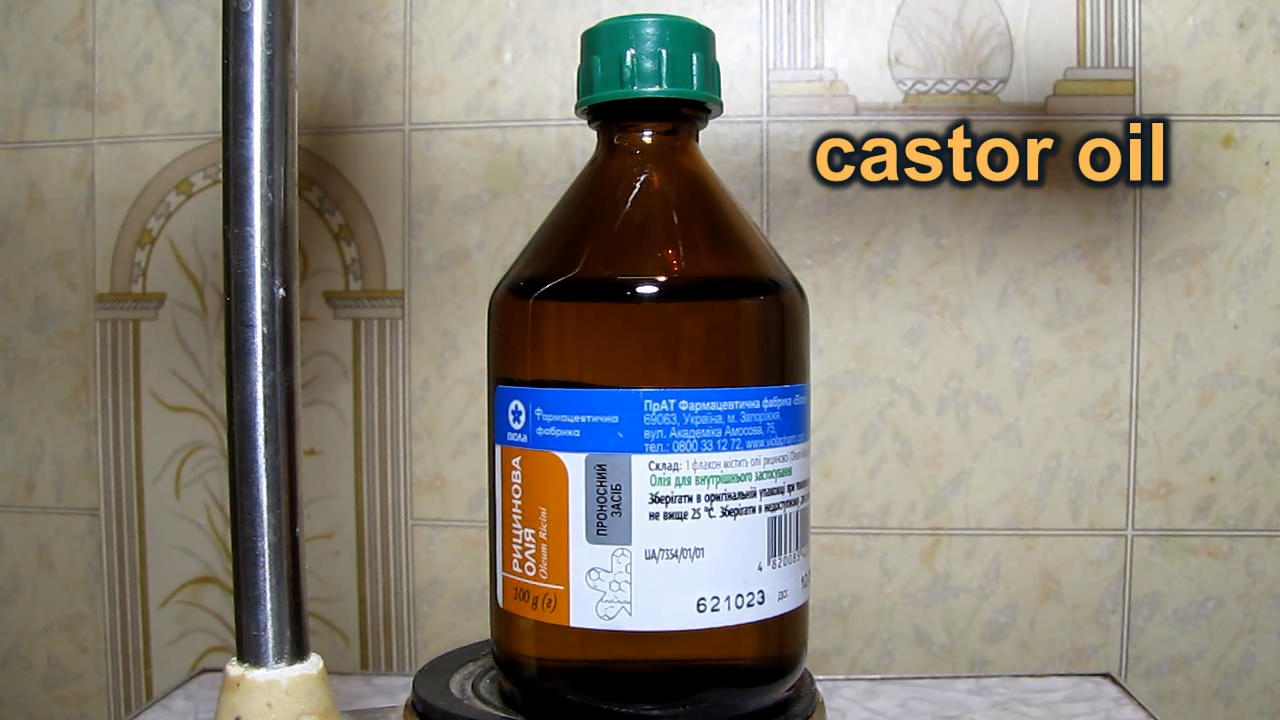
Castor oil, ethanol and water (oil dissolves in ethyl alcohol) |
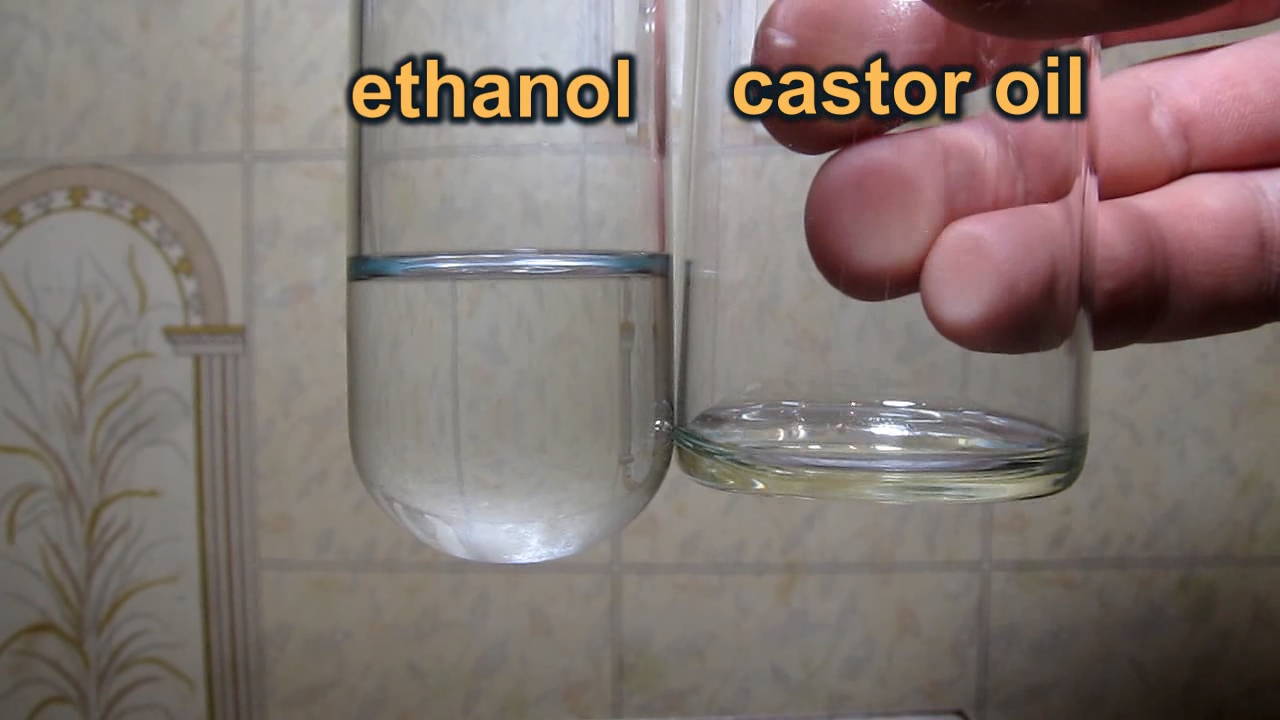
|

|

|

|
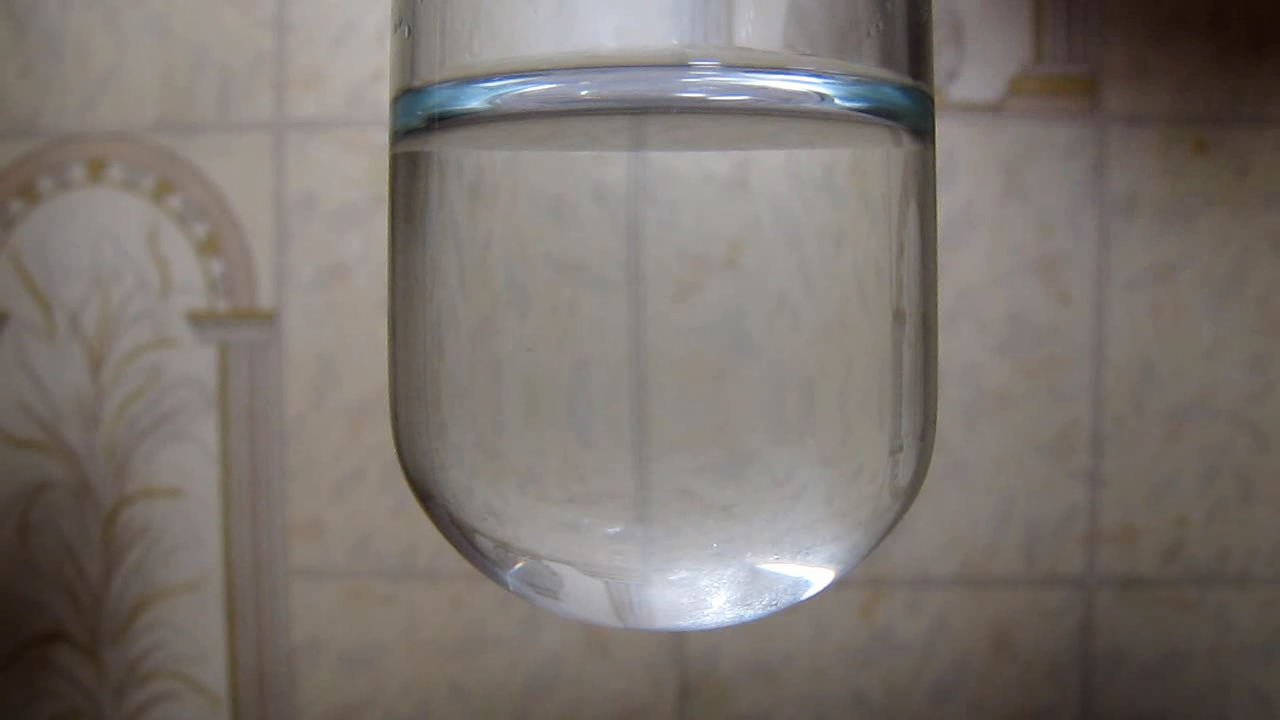
|

|
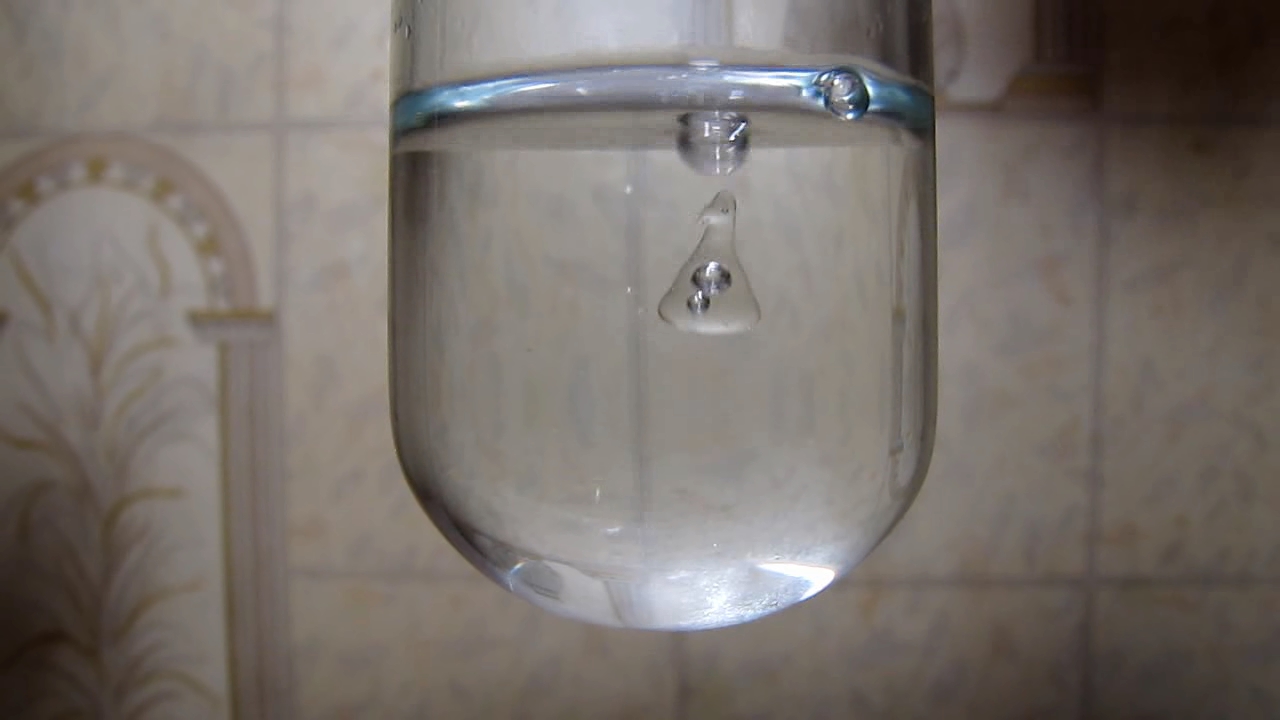
|

|
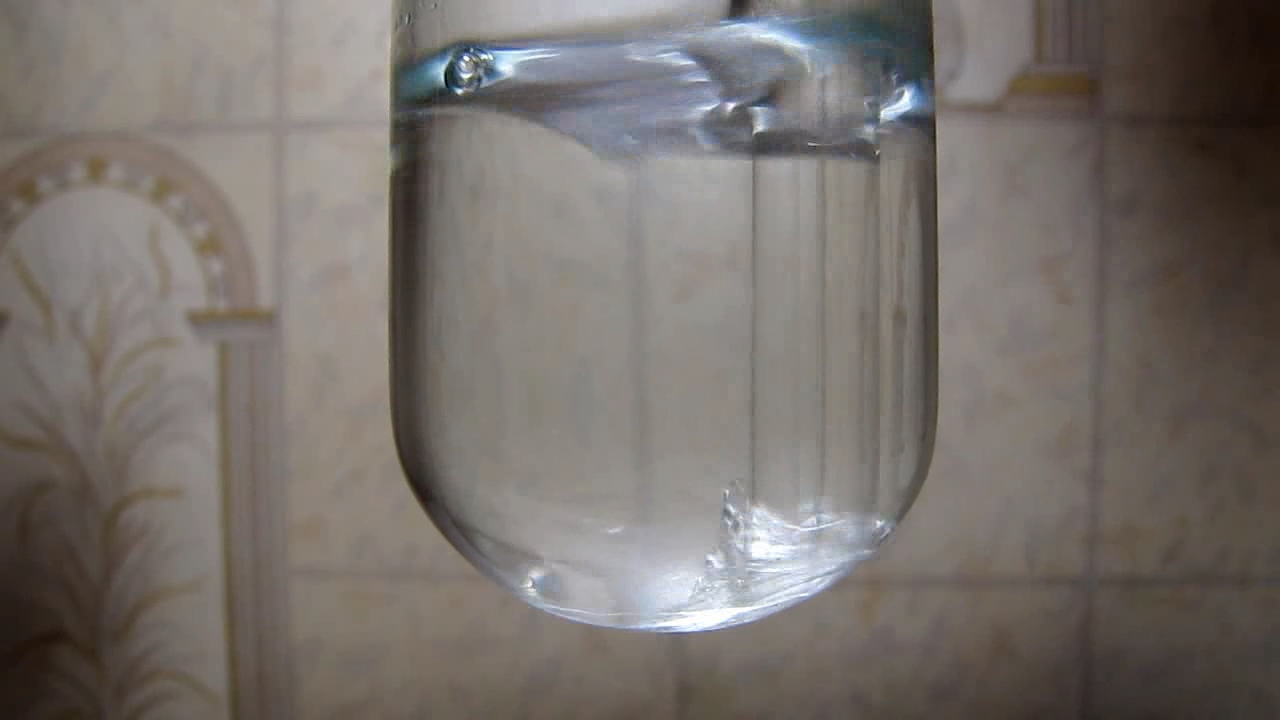
|
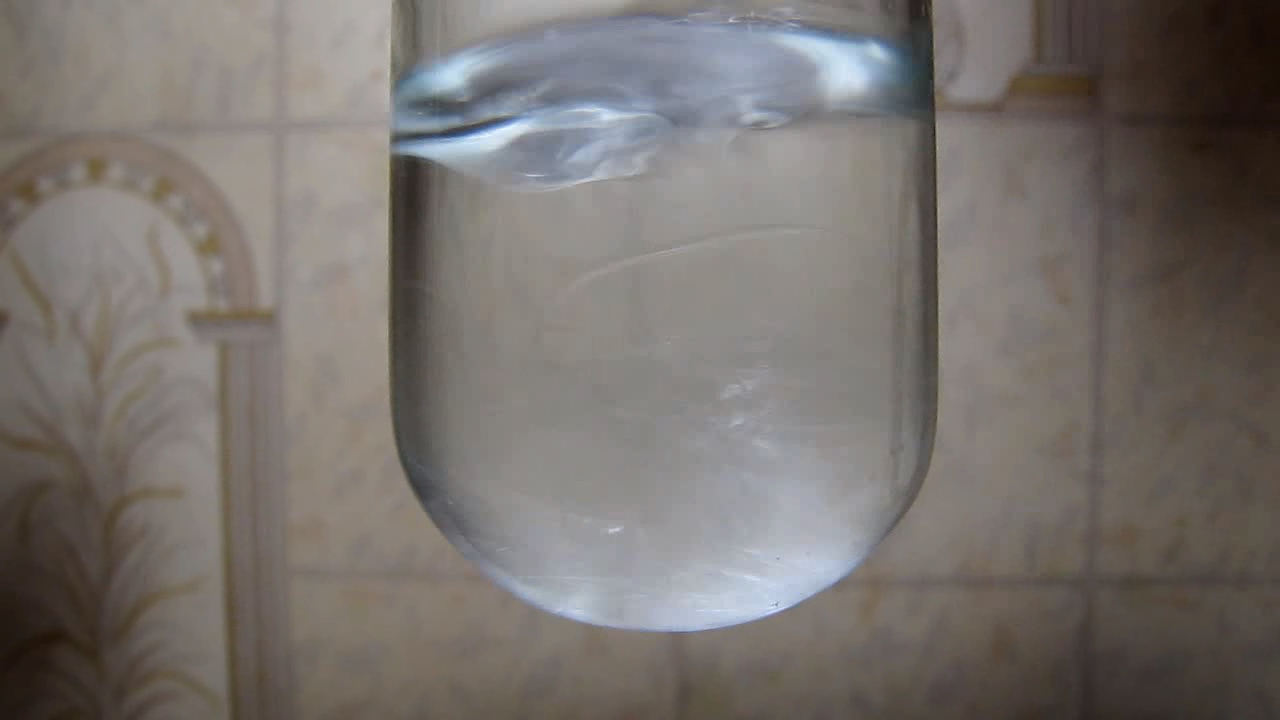
|
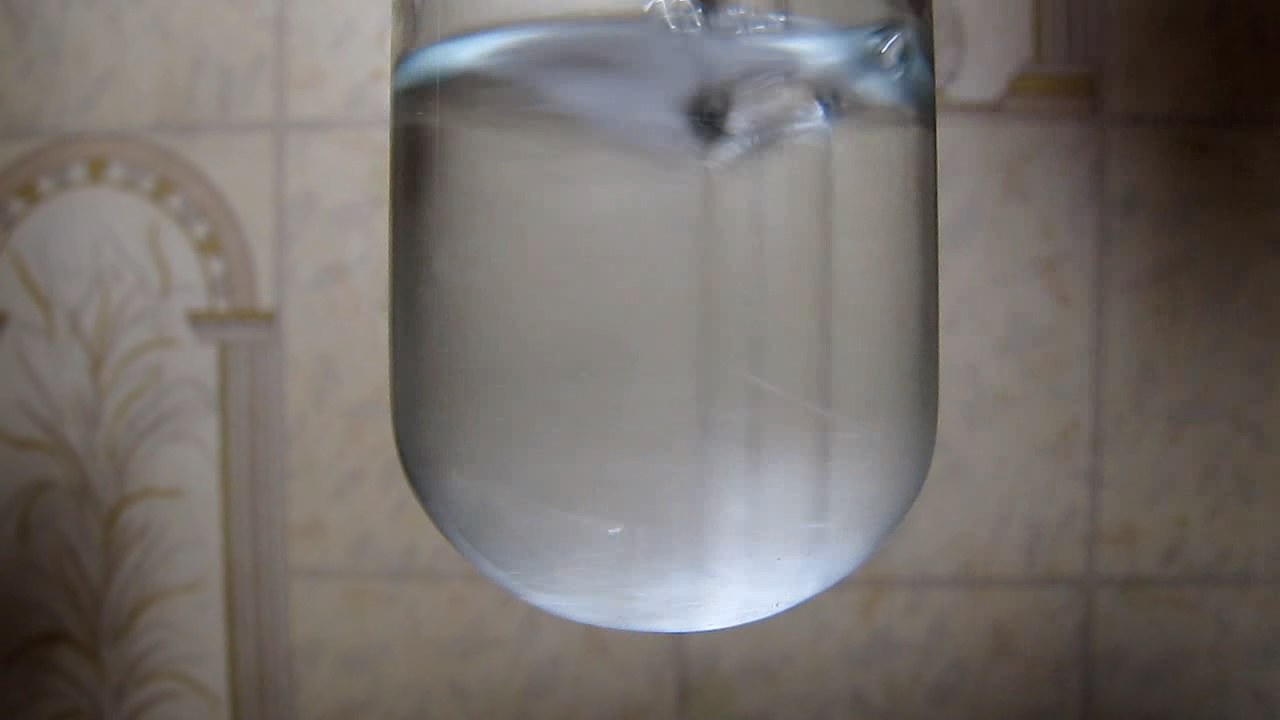
|

|
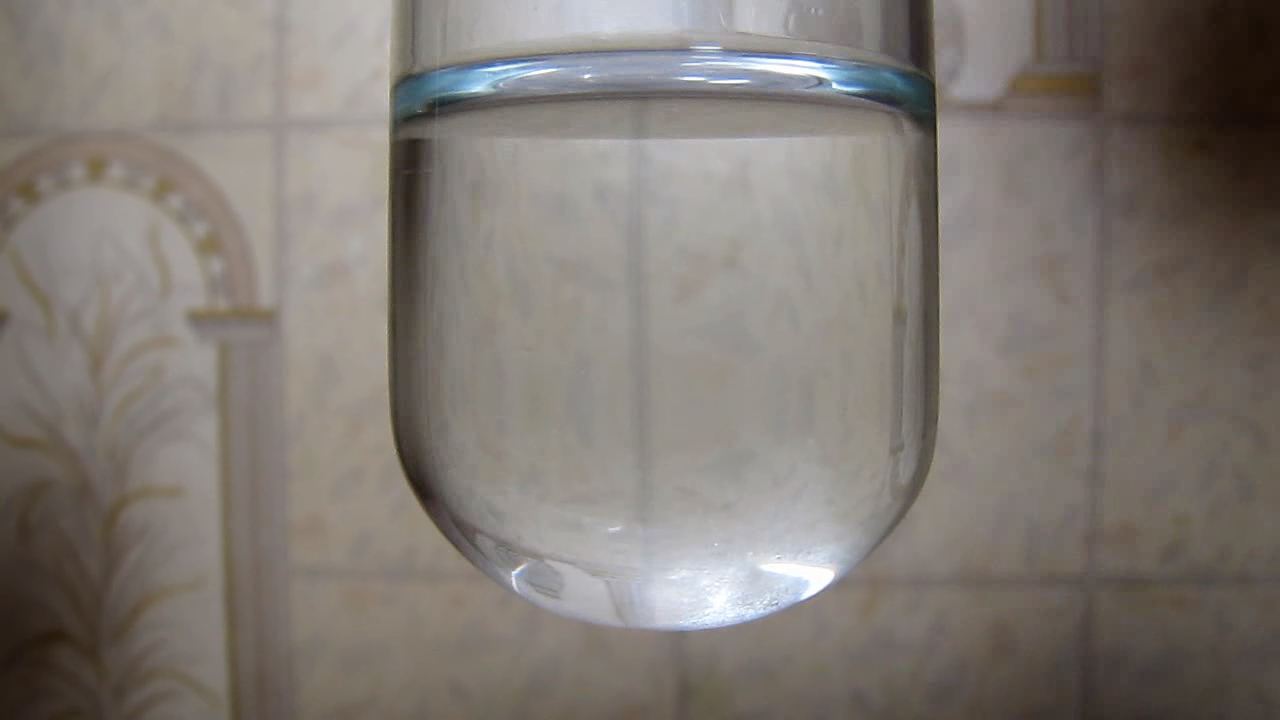
|

|
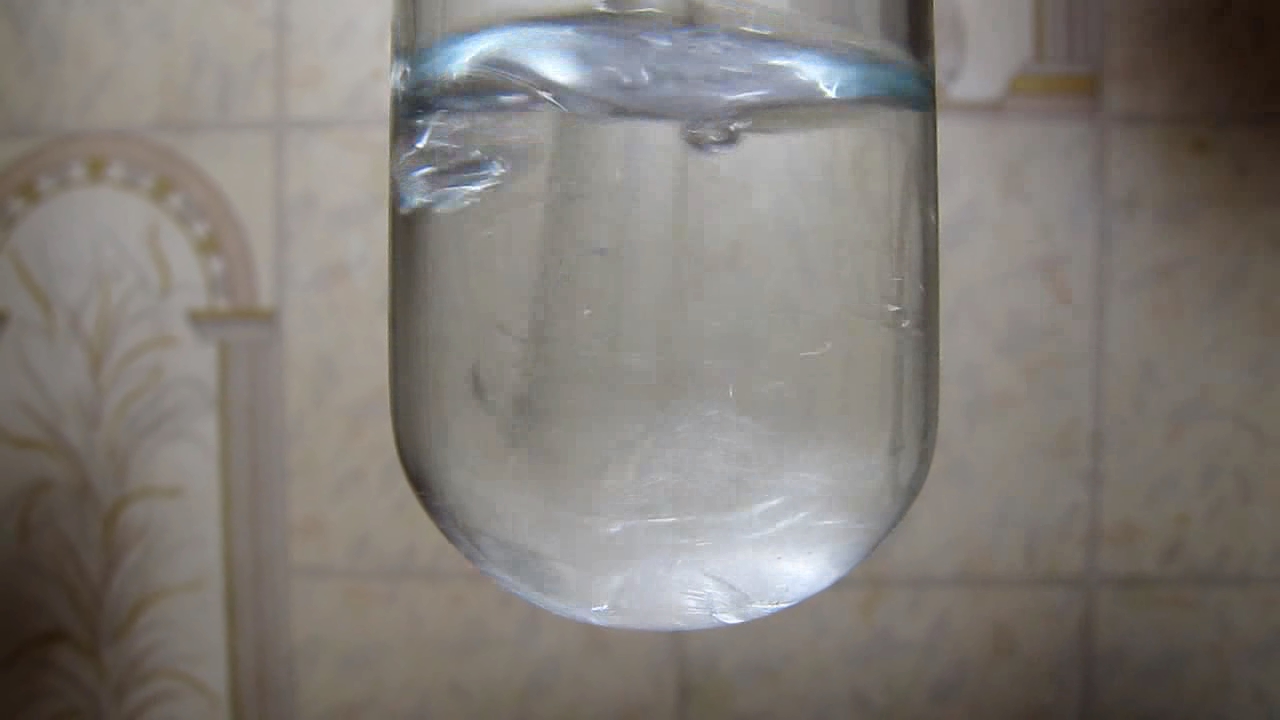
|
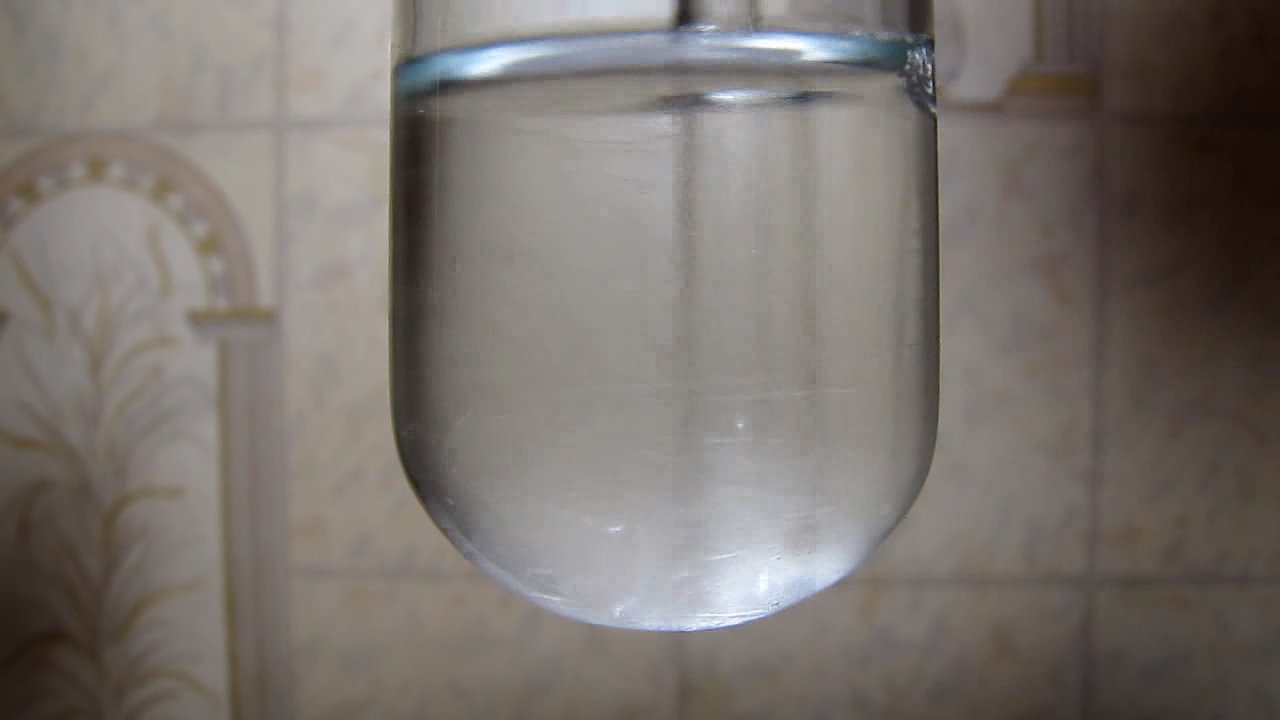
|

|
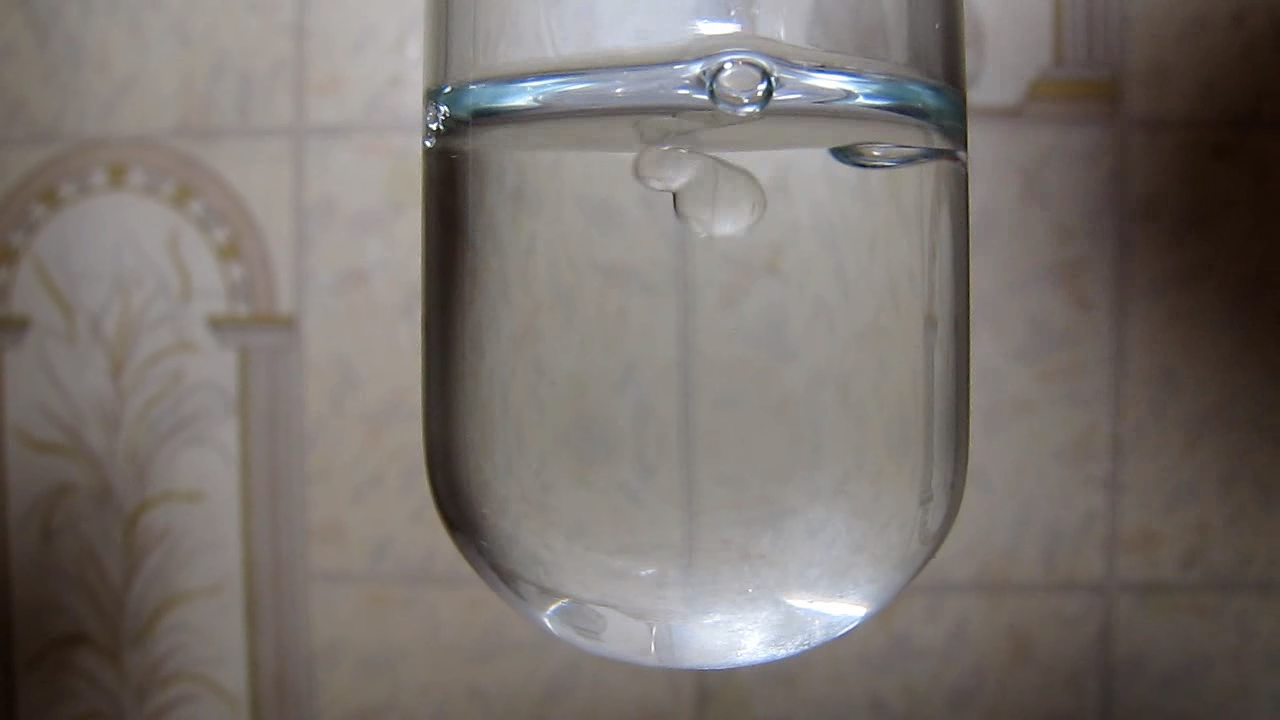
|
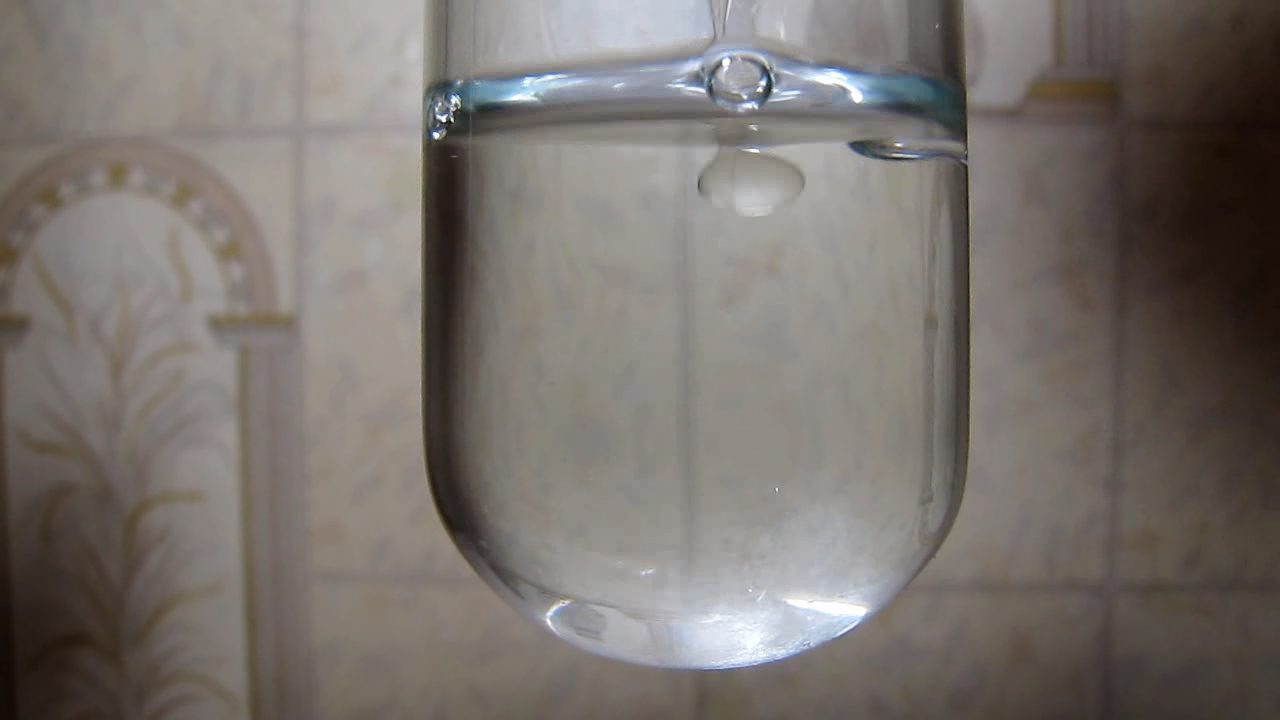
|

|

|
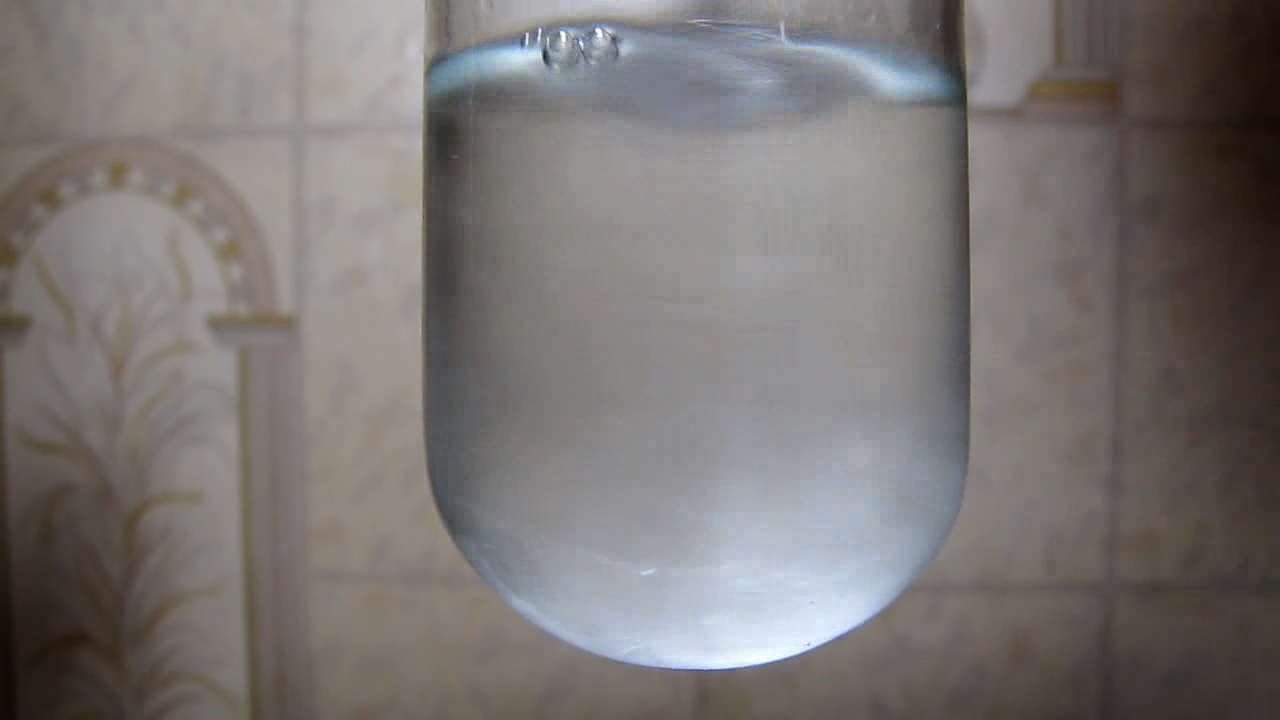
|
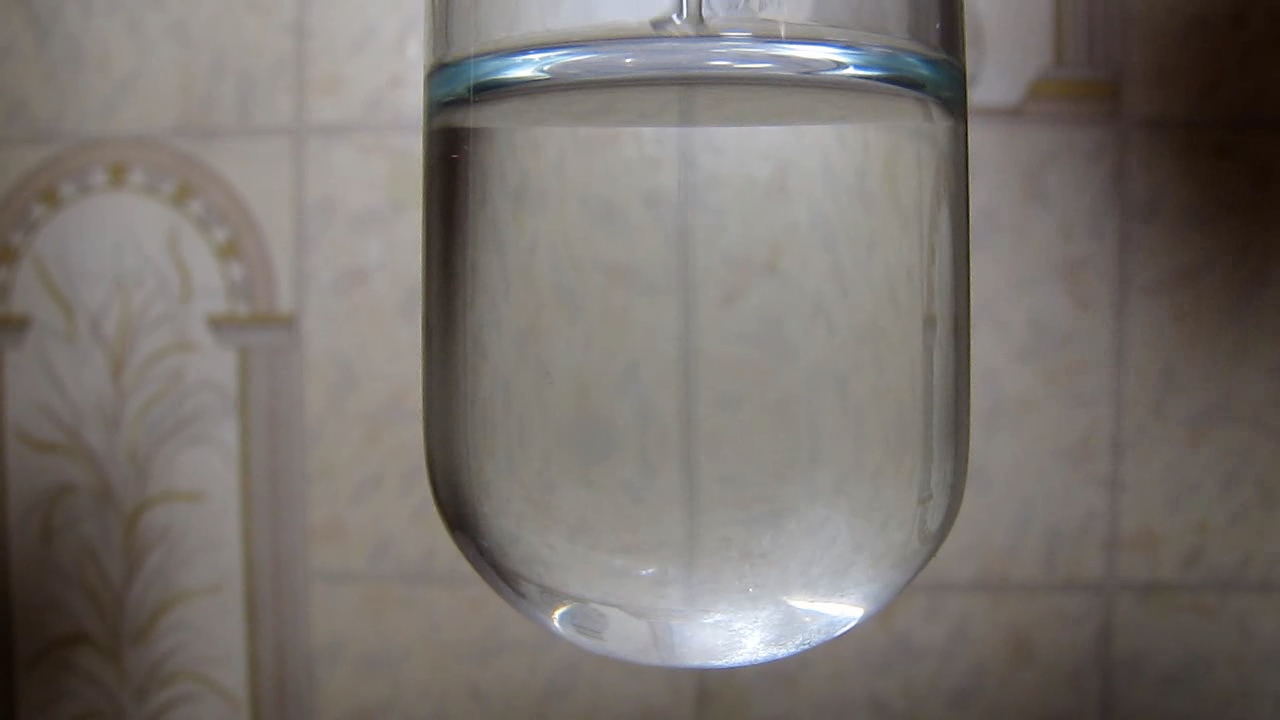
|

|

|
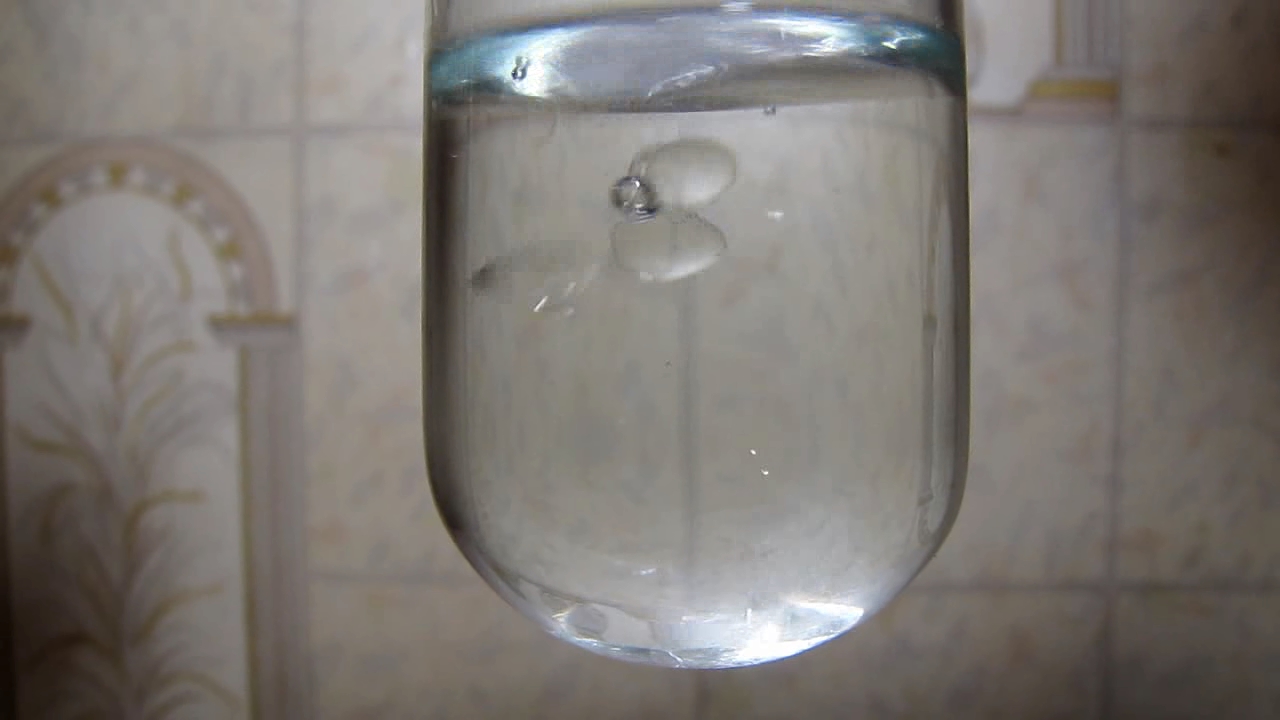
|
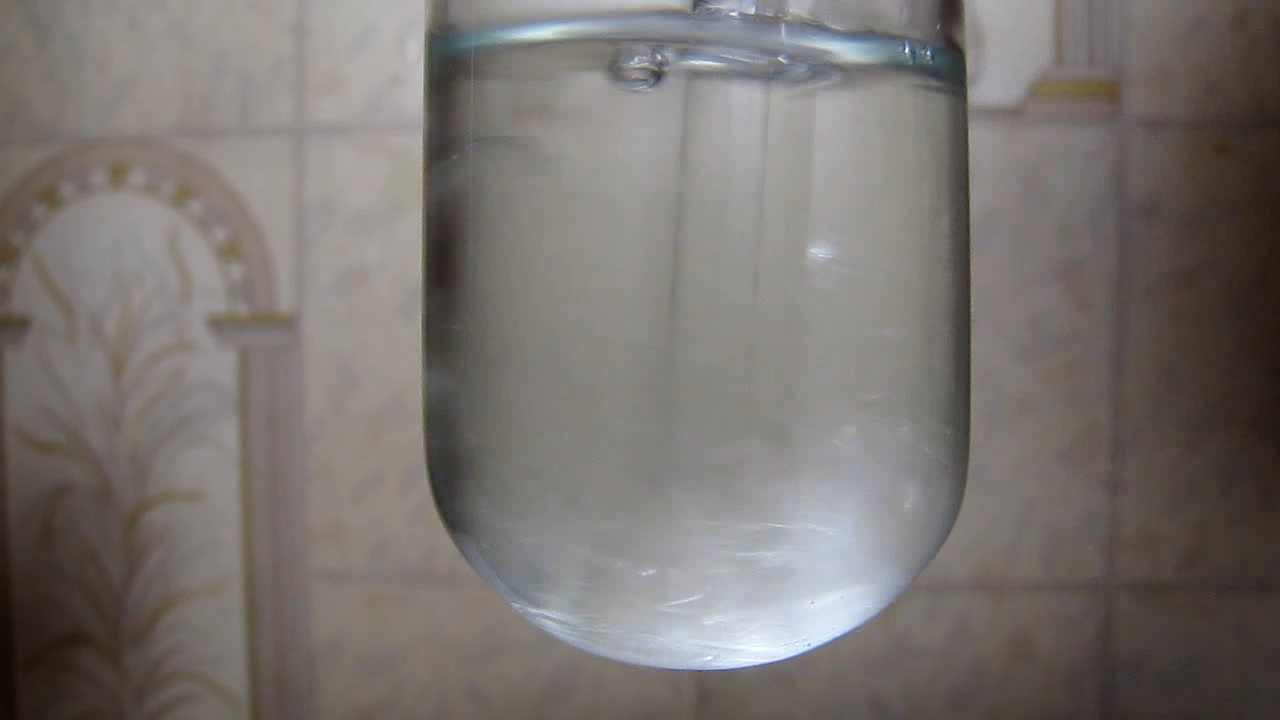
|

|

|

|
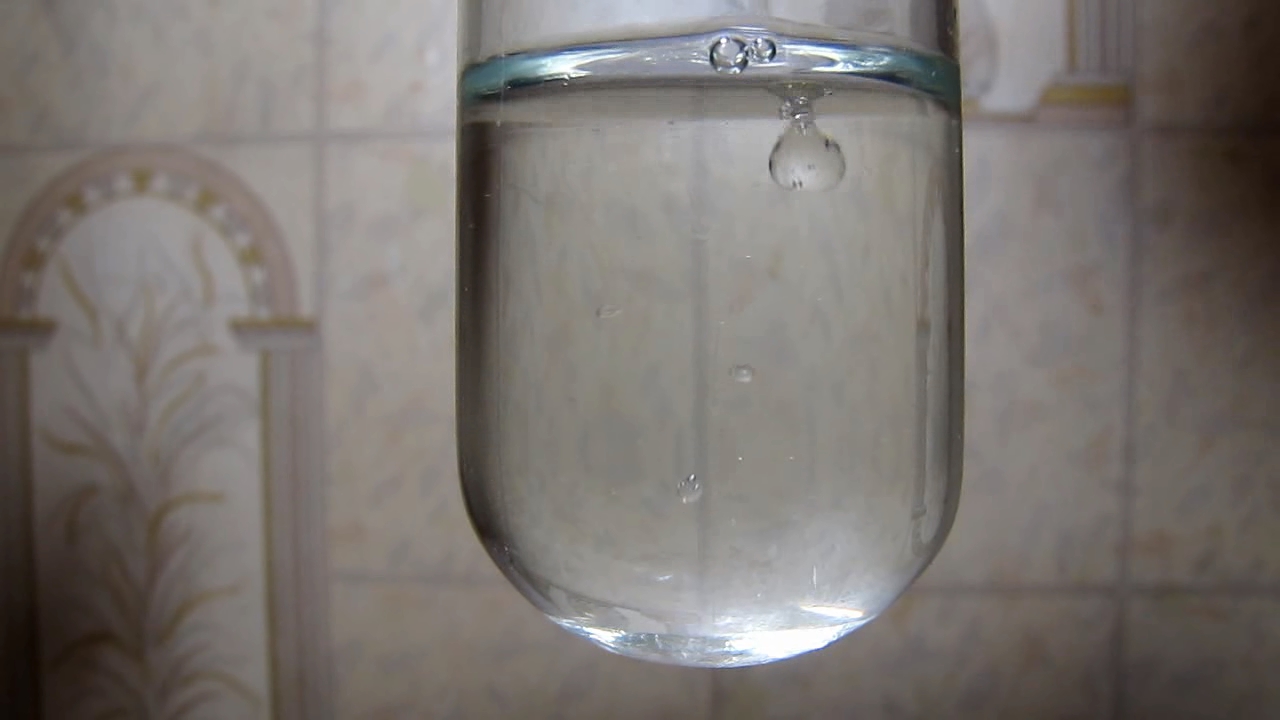
|
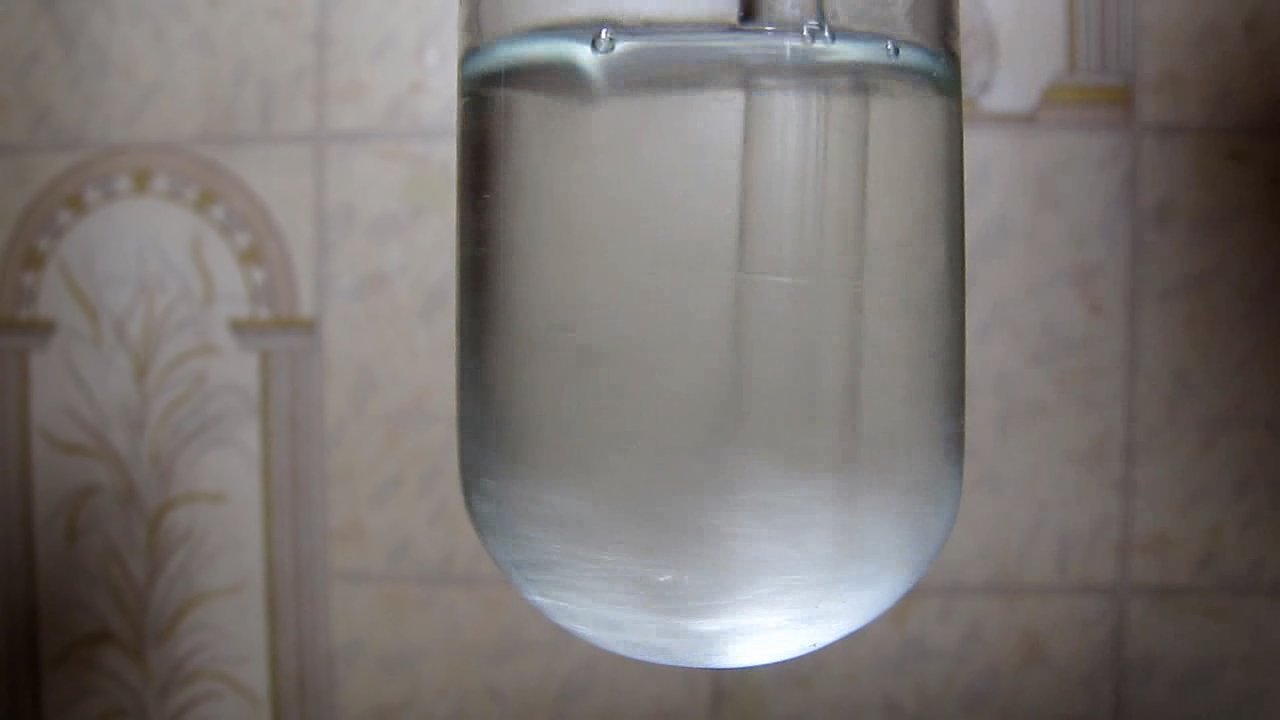
|

|
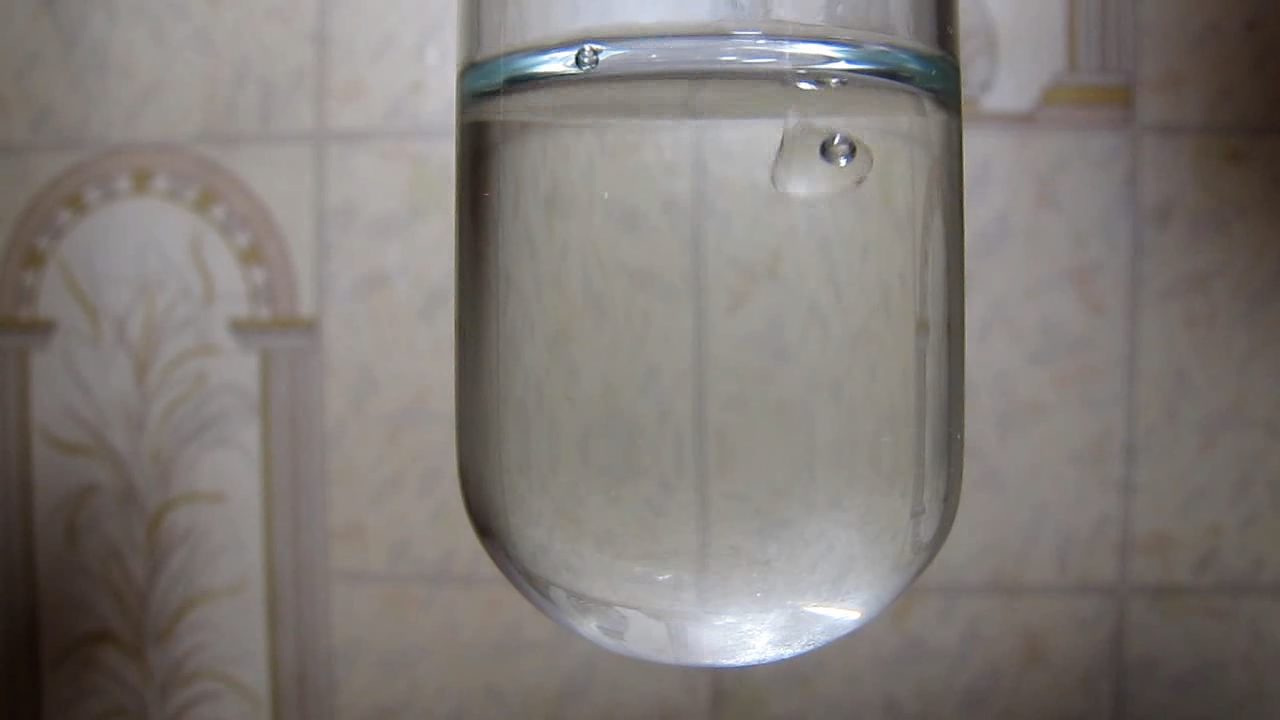
|
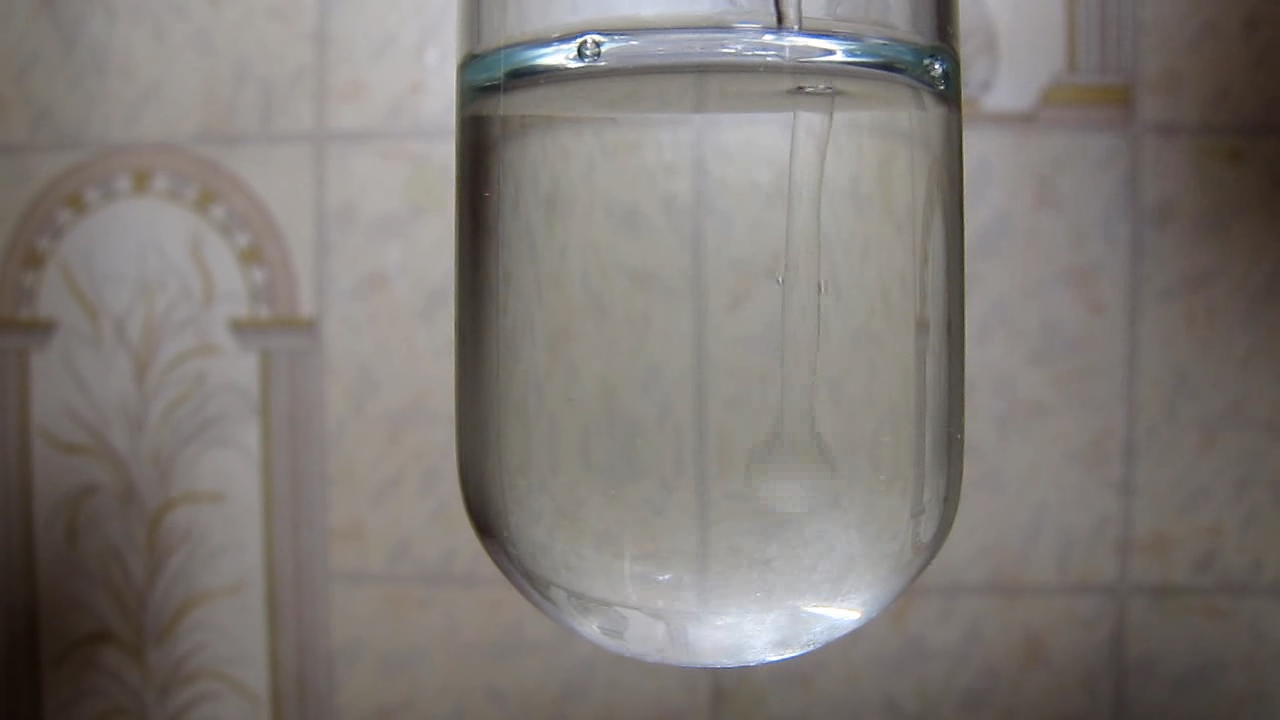
|

|
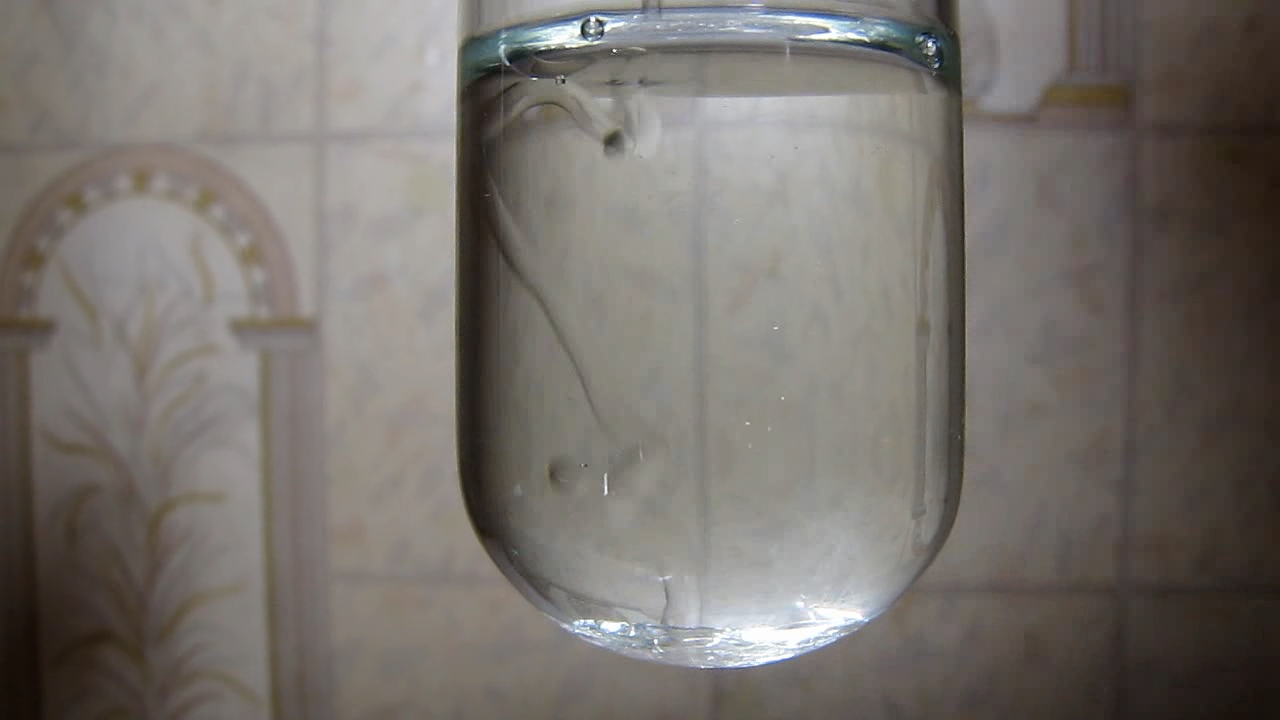
|
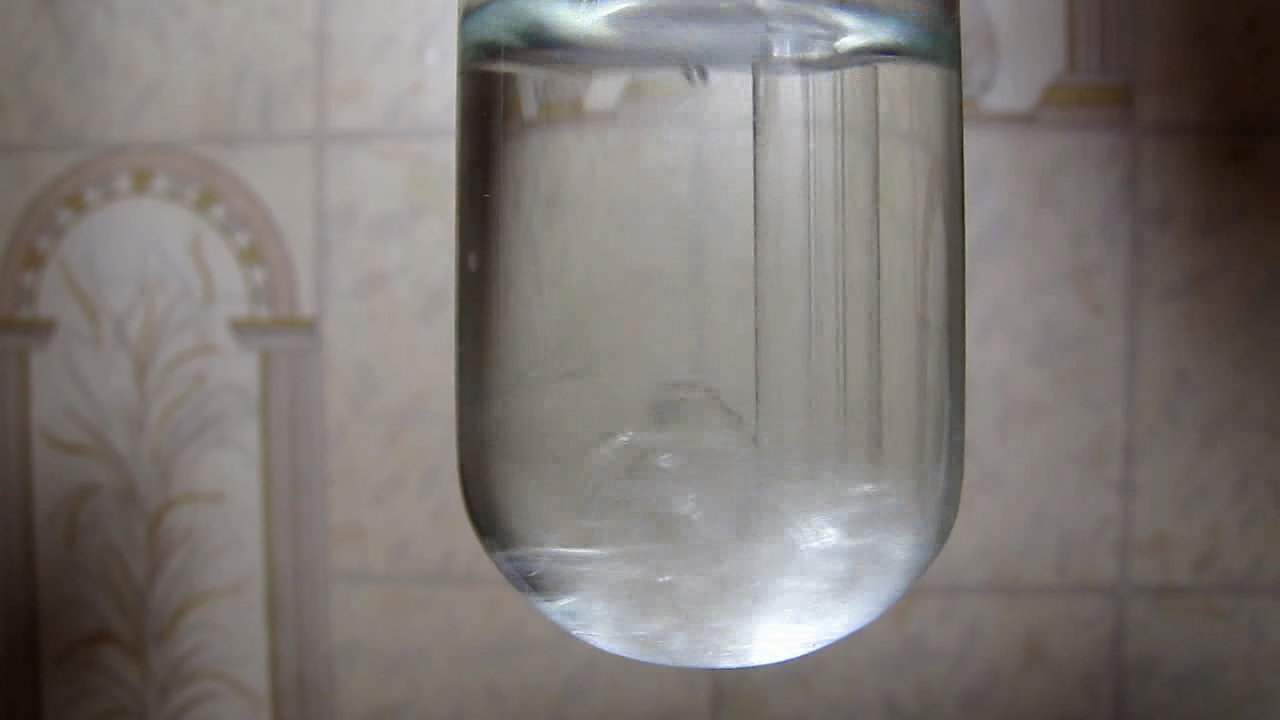
|
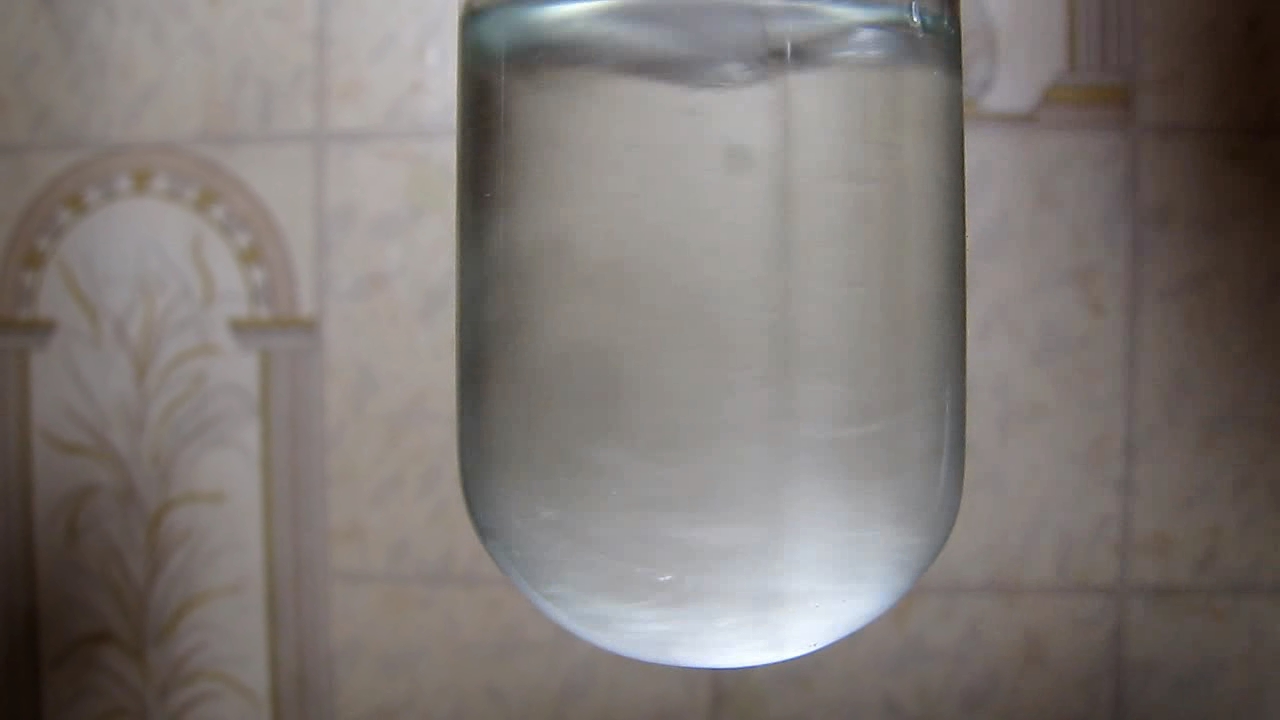
|
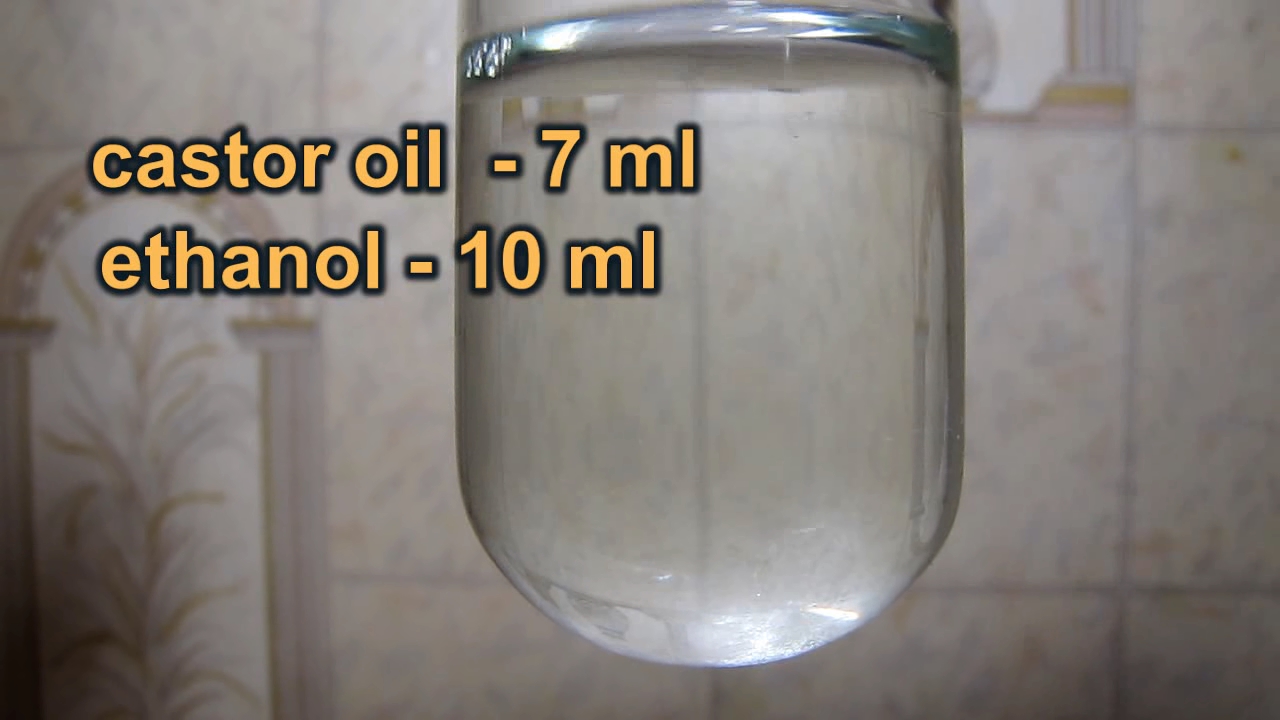
|
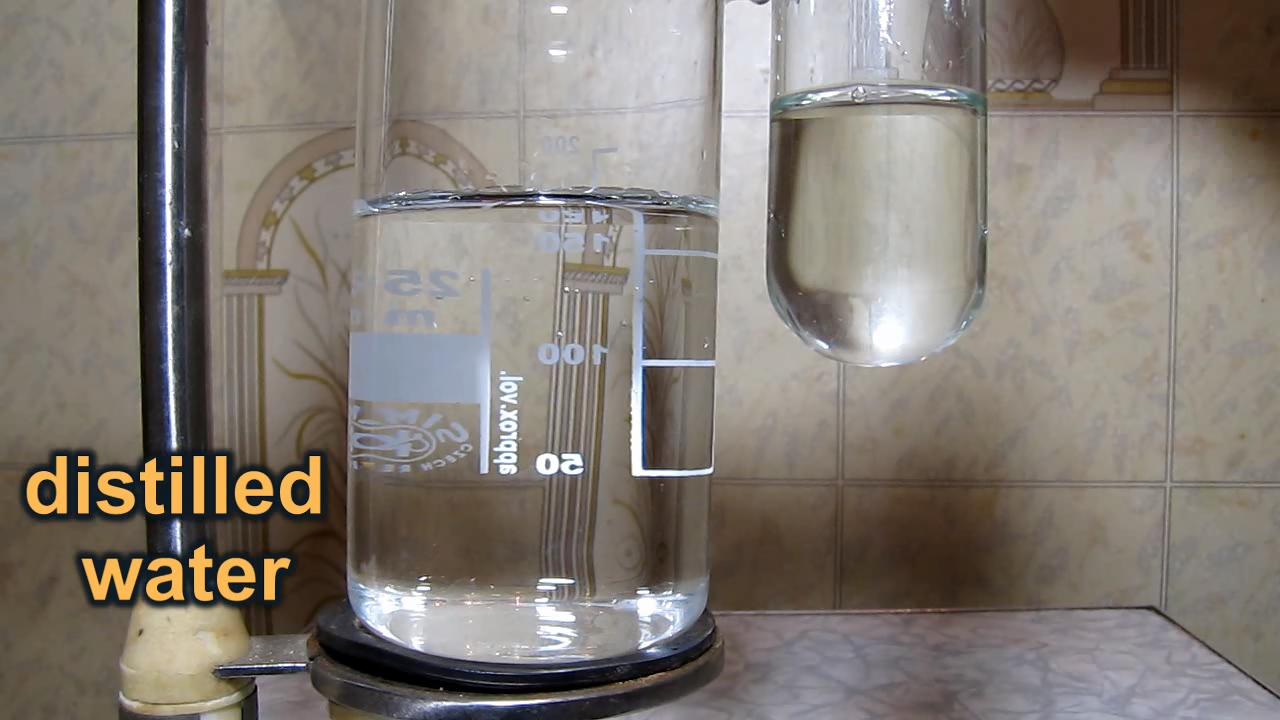
|
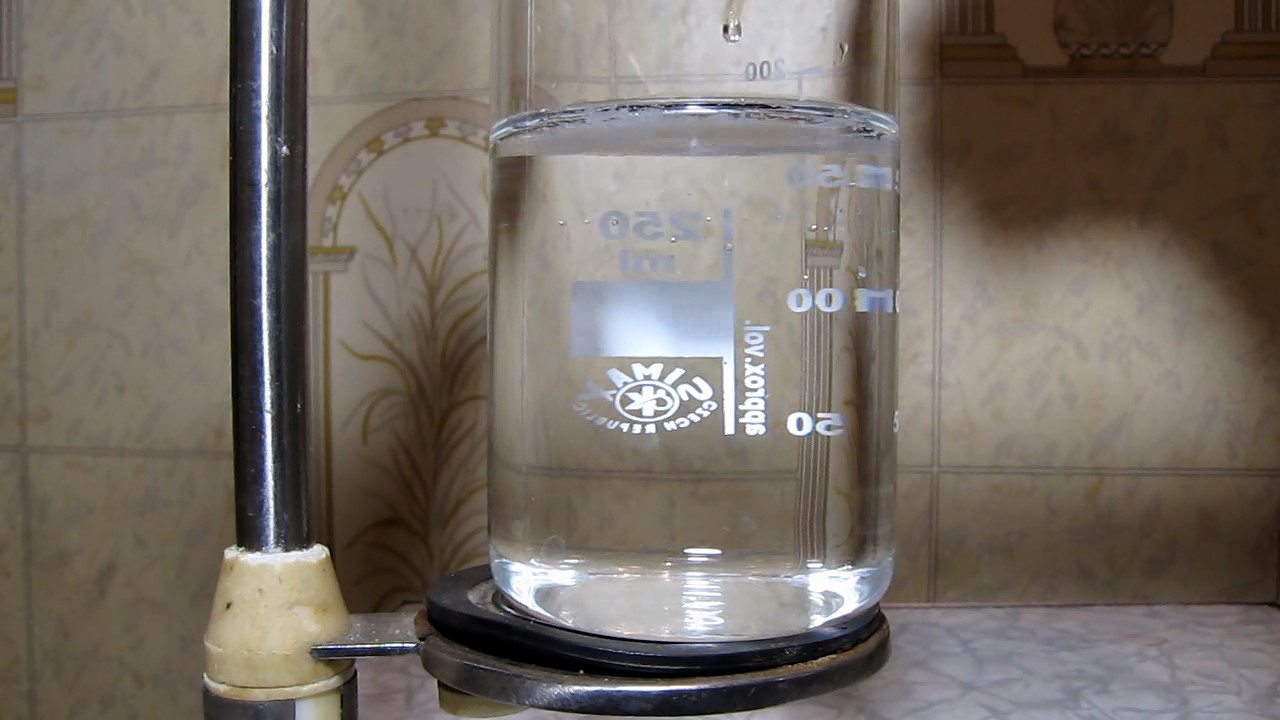
|
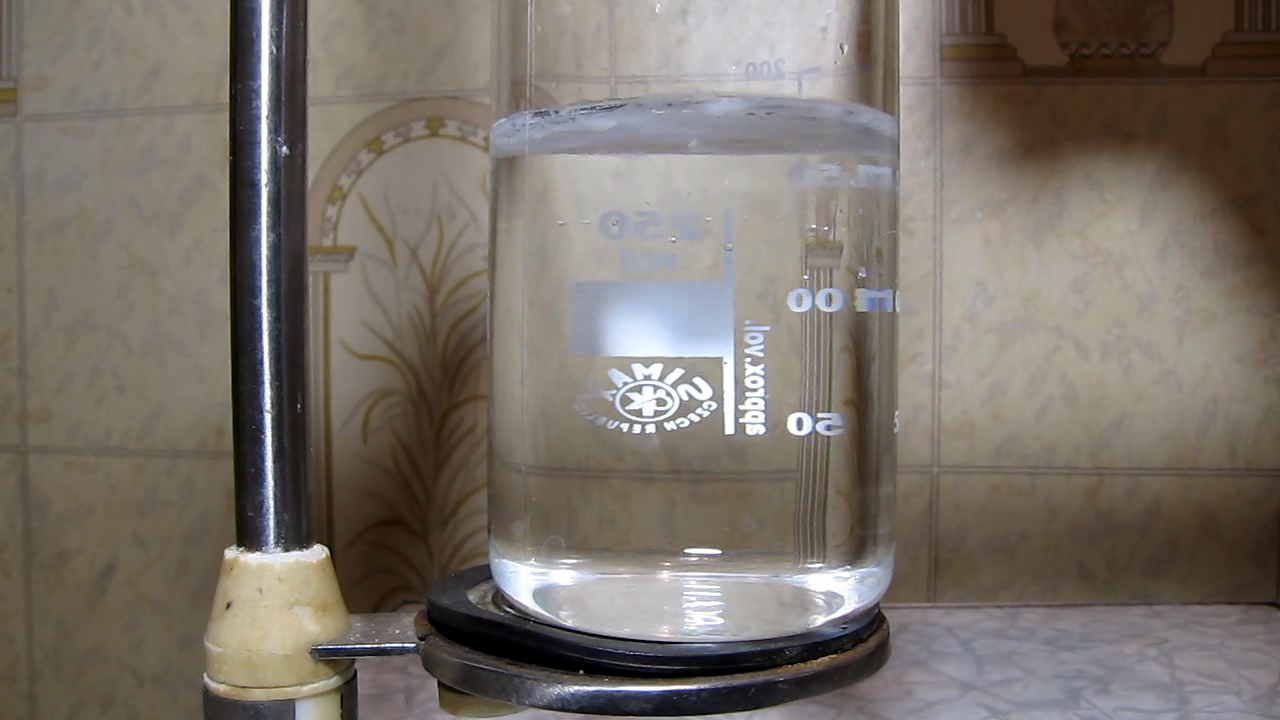
|
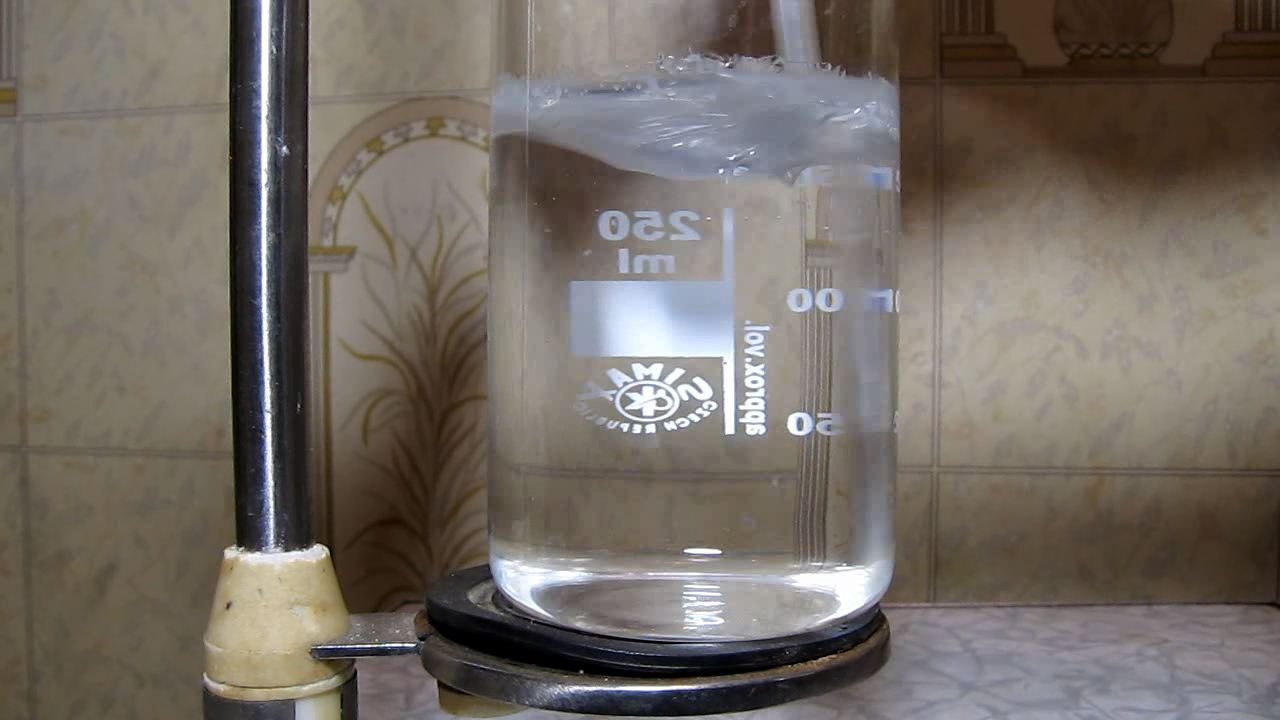
|
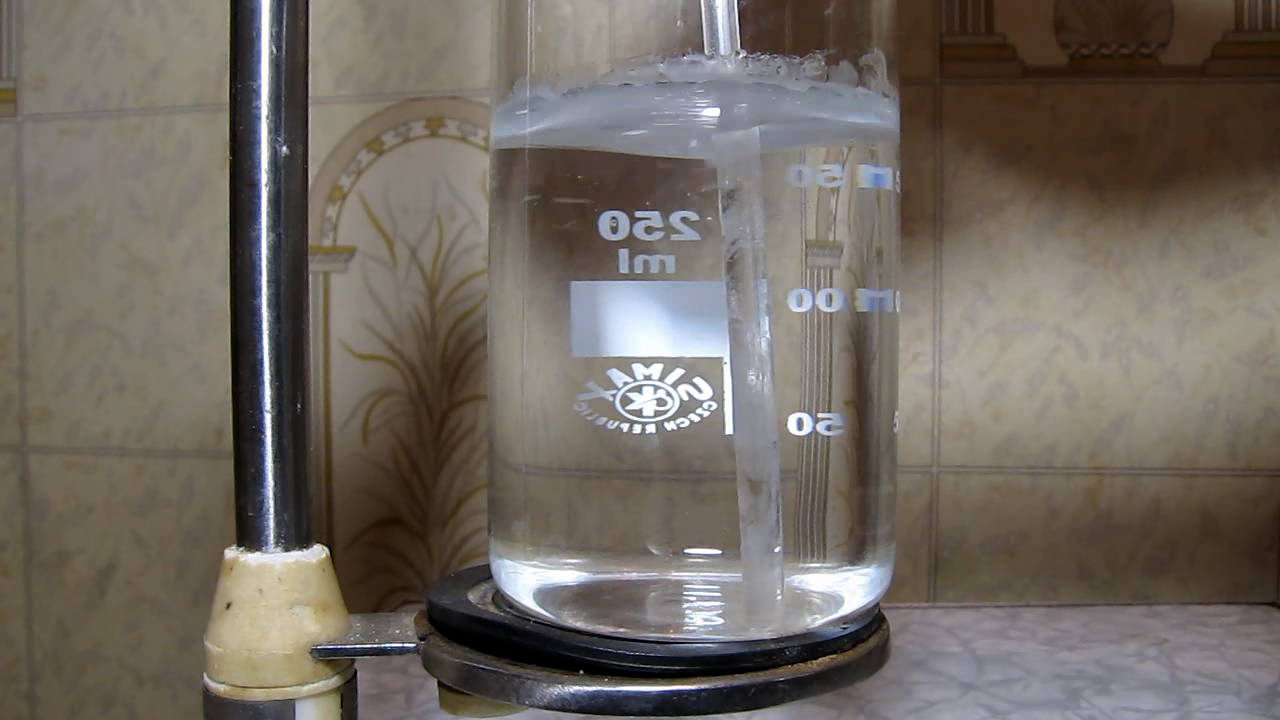
|
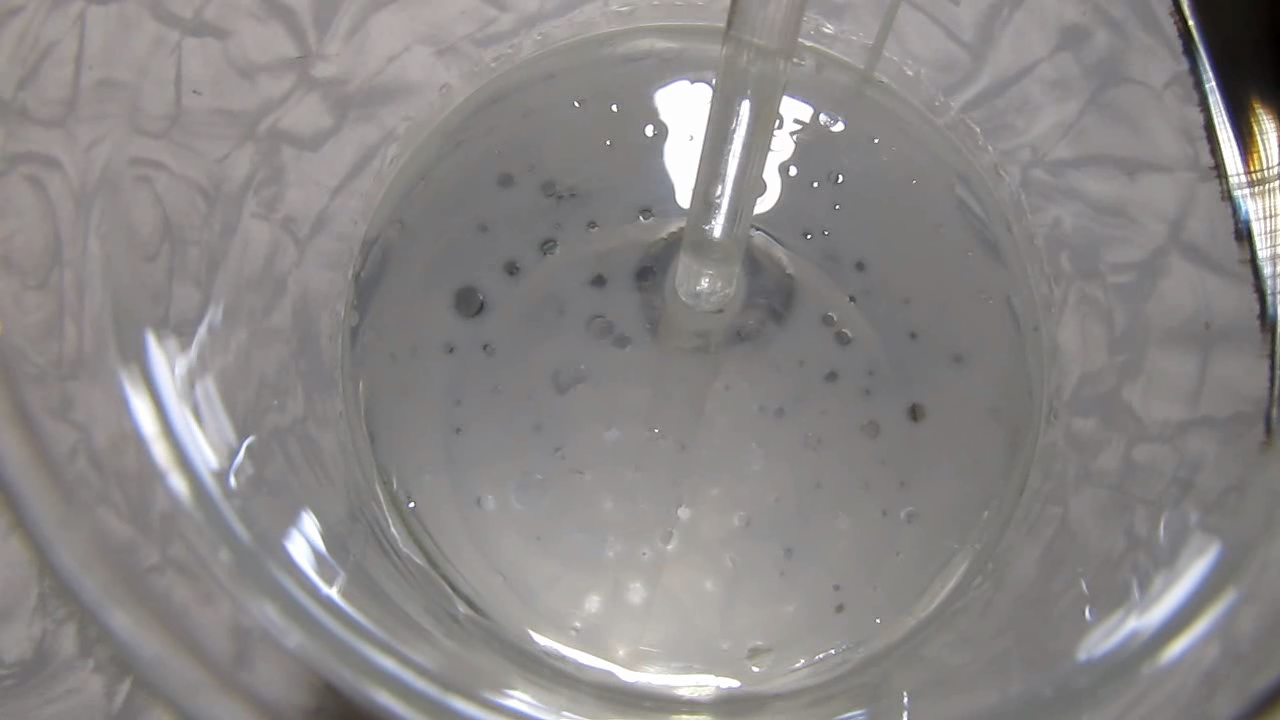
|
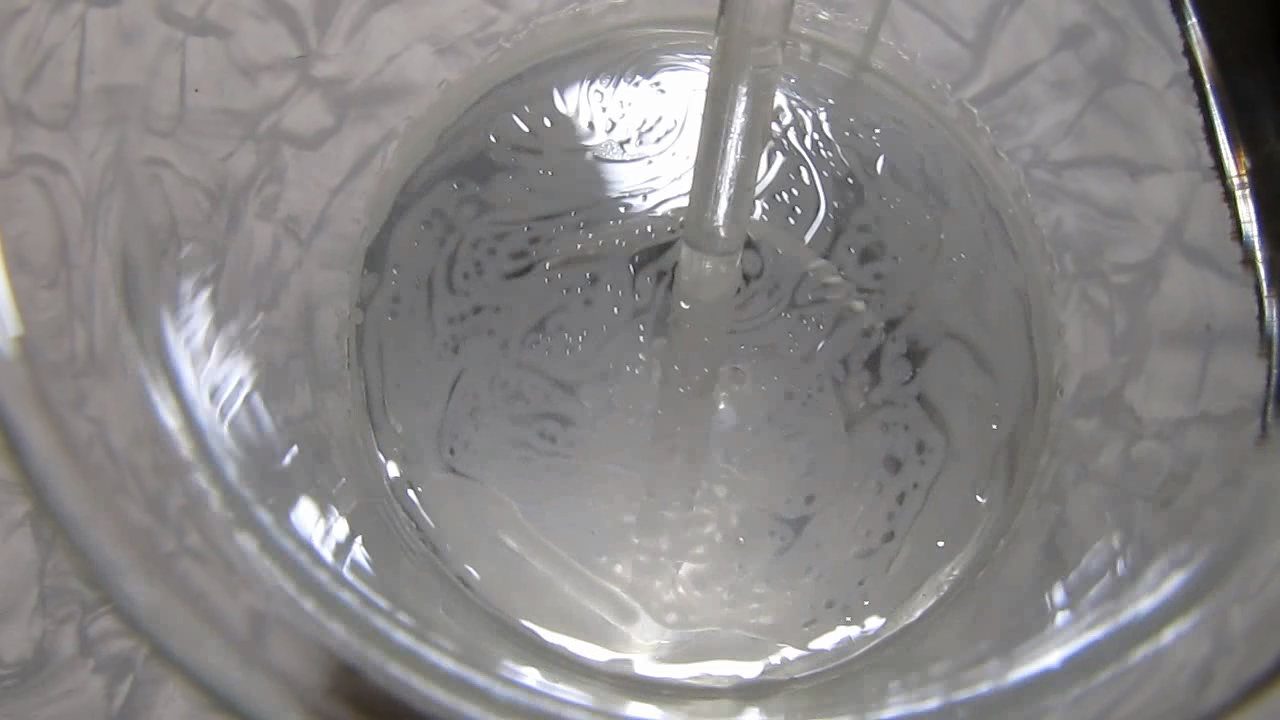
|
|
Having noticed a mistake in the text, allocate it and press Ctrl-Enter
Let us dissolve water in oil! (Ethanol, castor oil and water) - part 6
In the previous experiment, 1 ml of a solution prepared from 10 ml ethanol and 7 ml castor oil was added to excess water. As a result, no oil-in-water emulsion was formed. A water-in-oil emulsion formed, which collapsed when standing.
Растворим воду в масле! (Этанол, касторовое масло и вода) - ч.6 After this, it was logical to add water to the remaining solution (ethanol-castor oil). My prediction is that, upon mixing, a water-in-oil emulsion will form. So, I added about 0.5 ml of distilled water to the test tube with the solution. Drops of water sank to the bottom, became cloudy and turned white. On top, there was a solution of the oil in alcohol; at the bottom, a cloudy layer of water formed, indicating the presence of an oil-in-water emulsion. The boundary between the layers was unclear and diffuse. I mixed the contents of the test tube with a glass rod. At first, the liquid became white and cloudy: the lower layer was distributed throughout the volume of the mixture of alcohol and castor oil in the form of irregularly shaped droplets and streams. And then the unexpected happened... The water dissolved in the mixture of alcohol and oil! A transparent and colourless solution was formed, consisting of 6.5 ml of castor oil, 9.4 ml of ethanol and 0.5 ml of water [3]. The test tube contained a homogeneous liquid comprising ethanol, castor oil and water! I added another ~0.5 ml of distilled water to the test tube. Drops of water, sinking to the bottom, became white and cloudy. Again, two layers formed: the top layer was colourless and transparent, and the bottom layer was white and cloudy. Then, I stirred the liquid with a glass rod. The added water did not dissolve this time - a white, opaque emulsion formed in the test tube. The liquid began slowly to separate into two layers. I added another ~0.5 ml of distilled water and stirred, then left the test tube staying. The contents of the test tube gradually separated into two layers, each of which was white and cloudy. The top layer was a water-in-oil emulsion; the bottom layer was an oil-in-water emulsion (more precisely, the dispersion medium was not water but an aqueous solution of alcohol). I left the tube for 24 hours. The top layer became transparent and colourless: the water-in-oil emulsion had broken down. The bottom layer remained white and opaque (the oil-in-water emulsion remained). After this, I directed a green laser at the test tube to observe the Tyndall effect. When the beam passed through the upper layer of liquid, a luminous line was visible on the side. This meant dispersed particles were also in the upper layer of liquid. The colour of the beam in the liquid was green with a yellow tint (although the oil layer appeared colourless, and the original beam had no yellow tint). When the beam hit the lower layer of the emulsion, a bright glow was observed, which occupied the entire volume of the layer or most of it. The light scattered by the emulsion reminded me of old silver photographs (silver-gelatine photography). It had the same grainy texture. The "grains " appeared due to the scattering of light with the oil droplets contained in the emulsion. Before the widespread advent of digital photography, people usually used the gelatin-silver process to obtain images. The essence of this process is simple, although capturing photographs with it was challenging, unreliable, and highly inconvenient. A special photosensitive layer was applied to polymer film (photographic film), paper (photo paper) or other photographic materials. This layer was known as "photographic emulsion". It consisted of gelatine (gelatin) in which particles of silver halides were dispersed. Thanks to silver halides, it has become possible to obtain images of surrounding objects on the surface of flexible polymer film, paper, and, less commonly, on glass, porcelain and other materials. When an image (such as your face) was exposed to photographic film, the silver halides were partially decomposed by light, resulting in a latent image on the film (invisible to the eye). This picture was not only hidden but also unstable. After exposure, even the slightest light, hitting the photographic film, destroys the resulting latent image. The fact is that the captured photographic film remained sensitive to light. This is a fundamental difference between the gelatine-silver process and modern digital photography. The film was treated with a special solution known as a developer to render the image visible. This step was referred to as the "developing" of photographic film or paper. Consequently, the latent image became visible, but it retained sensitivity to light. Exposure to light rays would turn the image black. To stabilise the image, the developed film or paper was washed and subjected to another solution, a photographic fixer (the process termed "fixing"). The photographic fixer effectively eliminated residues of photosensitive compounds (silver halides). Once fixed, the image on the film or paper was no longer sensitive to light damage and could endure for many years. Speaking not strictly, a grain (particle) of silver halide on photographic film/photo paper was an analogue of a pixel on a modern monitor. This is why old photos sometimes appear grainy; the photographic emulsion distorts the image, much like a monitor with insufficient pixel quantity. It was precisely this structure that the rays scattered by the emulsion reminded me of. Unfortunately, this effect could not be captured on video.  By the way, when I was a child, I thought about ways of achieving a solution that combines water and vegetable oil (the two immiscible liquids). At that time, acetone was an available solvent and freely sold in stores. Acetone was used to remove oil paint stains from hands and clothes. Later, the sale of acetone was practically banned under flimsy pretexts. The facts are that sunflower oil is easily soluble in acetone; water also dissolves easily in acetone. First, add a little sunflower oil to the acetone, stir until dissolved, and then add a little water. The water should dissolve. I was not sure of the success of this experiment. For example, water might not dissolve in acetone, which contains oil. Or, during water dissolution, the oil may separate and form a distinct layer, essentially leaving the solution. While I was in doubt, acetone disappeared from sale. I have never conducted this experiment. Later, acetone became available again, but I became interested in other, more fascinating experiments. As you can see, we can achieve this result without acetone. Photos/Video __________________________________________________ 3 The given liquid volumes are approximate. Initially, I added 7 ml of castor oil to 10 ml of alcohol, mixed the liquids and used 1 ml of the solution for the previous experiment. Then, I added 0.5 ml of water to the remaining mixture. The fact is that when mixing two liquids, the volume of the resulting solution is not necessarily equal to the sum of the volumes of the original liquids. In this case, the additivity principle cannot be applied. For example, when mixing water and ethanol, the volume of the resulting solution will be less than the sum of the volumes of water and ethanol. In addition, the accuracy of the pipettes used leaves much to be desired. Приведенные объемы жидкостей приблизительны. Изначально к 10 мл спирта я добавил 7 мл касторового масла, смешал жидкости и использовал 1 мл полученного раствора для предыдущего эксперимента. Потом к оставшейся смеси добавил 0.5 мл воды. Дело в том, что при смешивании двух жидкостей объем полученного раствора не обязательно равен сумме объемов исходных жидкостей. В данном случае правило аддитивности не действует. Например, при смешивании воды и этанола объем полученного раствора будет меньше, чем сумма объемов воды и этанола. Кроме того, точность использованных пипеток заставляет желать лучшего. |
|
Растворим воду в масле! (Этанол, касторовое масло и вода) - ч.6
В прошлом эксперименте 1 мл раствора, приготовленного из 10 мл этанола и 7 мл касторового масла, был добавлен к избытку воды. В результате эмульсия масло-в-воде не образовалась. Образовалась эмульсия вода-в-масле, которая при стоянии разрушилась.
После этого было логично добавить воду к оставшемуся раствору (этанол - касторовое масло). Мой прогноз: после перемешивания образуется эмульсия вода-в-масле. Итак, в пробирку с раствором я добавил около 0.5 мл дистиллированной воды. Капли воды опустились на дно, стали мутными и приобрели белый цвет. До перемешивания образовалось два слоя жидкости. Сверху находился раствор масла в спирте, снизу - мутный слой воды (образовалась эмульсия масло-в-воде). Граница между слоями была нечеткой (диффузной). Перемешал содержимое пробирки стеклянной палочкой. Сначала жидкость стала бело-мутной: нижний слой распределился по объему смеси спирта и касторового масла в виде капелек неправильной формы и струй. А дальше произошло неожиданное... Вода растворилась в смеси спирта и масла! Образовался прозрачный и бесцветный раствор, состоящий из 6.5 мл касторового масла, 9.4 мл этанола и 0.5 мл воды [3]. В пробирке была гомогенная жидкость, содержащая этанол, касторовое масло и воду! Добавил в пробирку еще ~0.5 мл дистиллированной воды. Капли воды, опускаясь на дно, стали белыми и мутными. Опять образовались два слоя: верхний слой был бесцветным и прозрачным, нижний слой - белым и мутным. Перемешал жидкости стеклянной палочкой. В этот раз добавленная вода не растворилась - в пробирке образовалась белая непрозрачная эмульсия. Жидкость стала медленно разделяться на два слоя. Добавил еще ~ 0.5 мл дистиллированной воды, перемешал. Оставил пробирку стоять. Содержимое пробирки постепенно разделилась на два слоя, каждый из которых был белым и мутным. Верхний слой представлял собой эмульсию вода-в-масле, нижний слой - эмульсию масло-в-воде (точнее, дисперсионной средой была не вода, а водный раствор спирта). Оставил пробирку на 24 часа. Верхний слой стал прозрачным и бесцветным: эмульсия вода-в-масле разрушилась. Нижний слой остался белым и непрозрачным (эмульсия масло-в-воде осталась). После этого направил на пробирку зеленый лазер, чтобы наблюдать эффект Тиндаля. При прохождении луча сквозь верхний слой жидкости, сбоку была видна светящаяся линия. Это означало, что в верхнем слое жидкости также были дисперсные частицы. Цвет луча в жидкости был зеленым с желтым оттенком (хотя слой масла выглядел бесцветным, а исходный луч не имел желтого оттенка). При попадании луча в нижний слой эмульсии наблюдалось яркое сияние, которое занимало весь объем слоя или большую его часть. Рассеянный эмульсией свет, напоминал мне старые серебряные фотографии. Он имел такую же зернистую структуру. Появление "зерен" было обусловлено рассеянием света в капельках масла, которые содержались в эмульсии. До массового появления цифровой фотографии люди обычно использовали желатиносеребряный процесс (gelatine-silver process) для получения изображений. Суть этого процесса проста, хотя делать фотографии с его помощью было не очень просто, ненадежно и очень неудобно. Специальный светочувствительный слой напросился на полимерную пленку (фотопленка), бумагу (фотобумага) или другие фотографические материалы. Сам этот слой назывался "фотографическая эмульсия" ("photographic emulsion"). Она представляла собой желатиновую основу, в которой были диспергированы частицы галогенидов серебра. Благодаря галогенидам серебра стало возможно получать изображения окружающих объектов на поверхности гибкой полимерной пленки, бумаги, реже - на поверхности стекла, фарфора и других материалов. Когда изображение (например, ваше лицо) экспонировали на фотографическую пленку, галогениды серебра частично разлагались под действием света, в результате на пленке возникало скрытое (невидимое глазу) изображение. Это изображение было не только невидимым, но и нестабильным. После экспозиции даже слабый свет, попадая на отснятую фотопленку, разрушал полученное скрытое изображение. Дело в том, что отснятая фотопленка сохраняла чувствительность к свету. В этом заключается фундаментальное отличие желатиносеребряного процесса от современной цифровой фотографии. Чтобы изображение стало видимым, пленку обрабатывали специальным раствором - проявителем. Сам процесс назывался "проявление" (фотографической пленки или фотобумаги). В результате скрытое изображение становилось видимым, но оно все еще боялось света. При попадании световых лучей изображение становилось черным. Поэтому проявленную пленку/бумагу промывали и обрабатывали другим раствором - закрепителем (сам процесс назывался "закрепление"). Фотографический закрепитель удалял остатки светочувствительных материалов (галогенидов серебра). После закрепления изображение на пленке или бумаге уже не разрушалось светом и оставалось на долгие годы. Если говорить нестрого, то зерно (частица) галогенида серебра на фотопленке/фотобумаге было аналогом пикселя на современном мониторе. Поэтому старые фотографии иногда выглядели зернистыми (фотографическая эмульсия искажает изображение, подобно монитору с недостаточным числом пикселей). Именно такую структуру и напомнили мне лучи, рассеянные эмульсией. К сожалению, на видео данный эффект запечатлеть не удалось.  Кстати, о возможности получить раствор, в котором одновременно находится вода и растительное масло - две несмешивающиеся жидкости, я задумался еще в детстве. Тогда ацетон был доступным растворителем, который свободно продавался в магазинах. С помощью ацетона смывали пятна масляной краски с рук и одежды. Позже продажу ацетона практически запретили под надуманными предлогами. Факты следующие: подсолнечное масло легко растворяется в ацетоне; вода тоже легко растворяется в ацетоне. Сначала добавить к ацетону немного подсолнечного масла, перемешать до растворения, а потом - добавить немного воды. Вода должна раствориться. Я не был уверен в успехе данного опыта. Например, вода могла не раствориться в ацетоне, который содержал масло. Или во время растворения воды масло могло образовать отдельный слой (т.е., "покинуть" раствор). Пока я сомневался, ацетон исчез из продажи. Этот эксперимент я так и не провел. Позже ацетон стал доступен снова, но я увлекся другими - более интересными экспериментами. Как видите, в данном случае можно обойтись и без ацетона. |

Let us dissolve water in oil! (Ethanol, castor oil and water) |
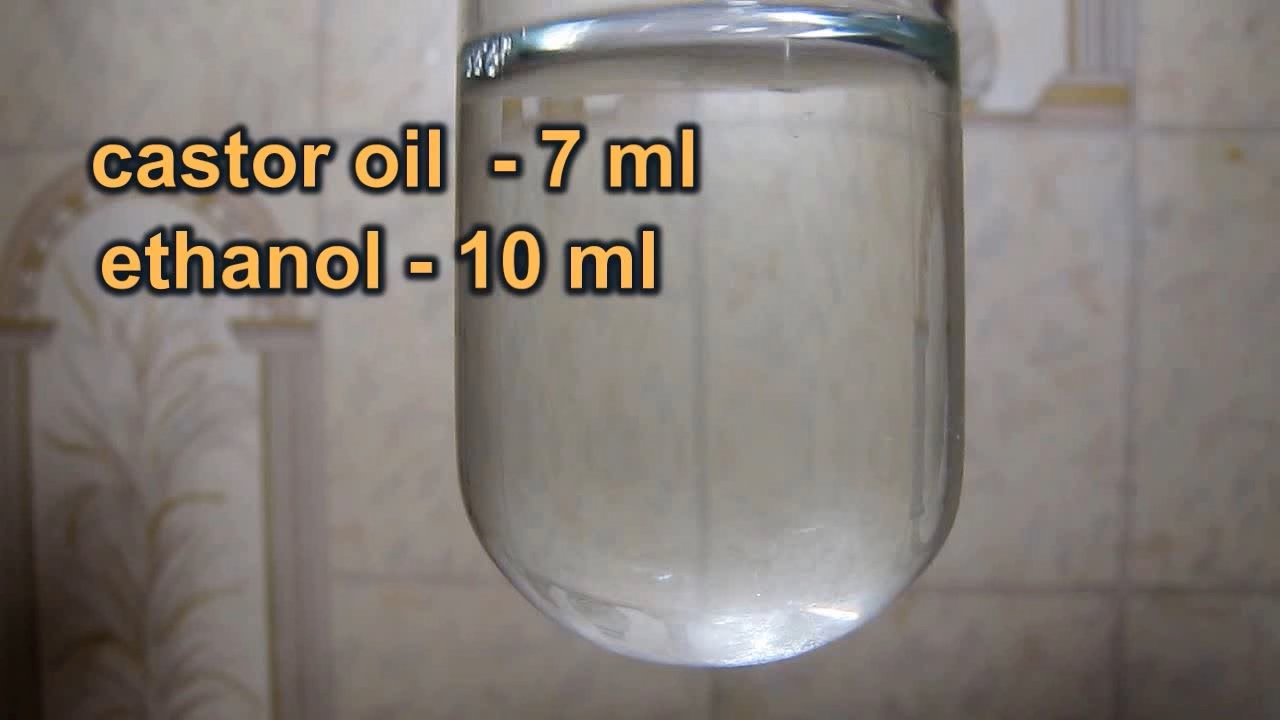
|
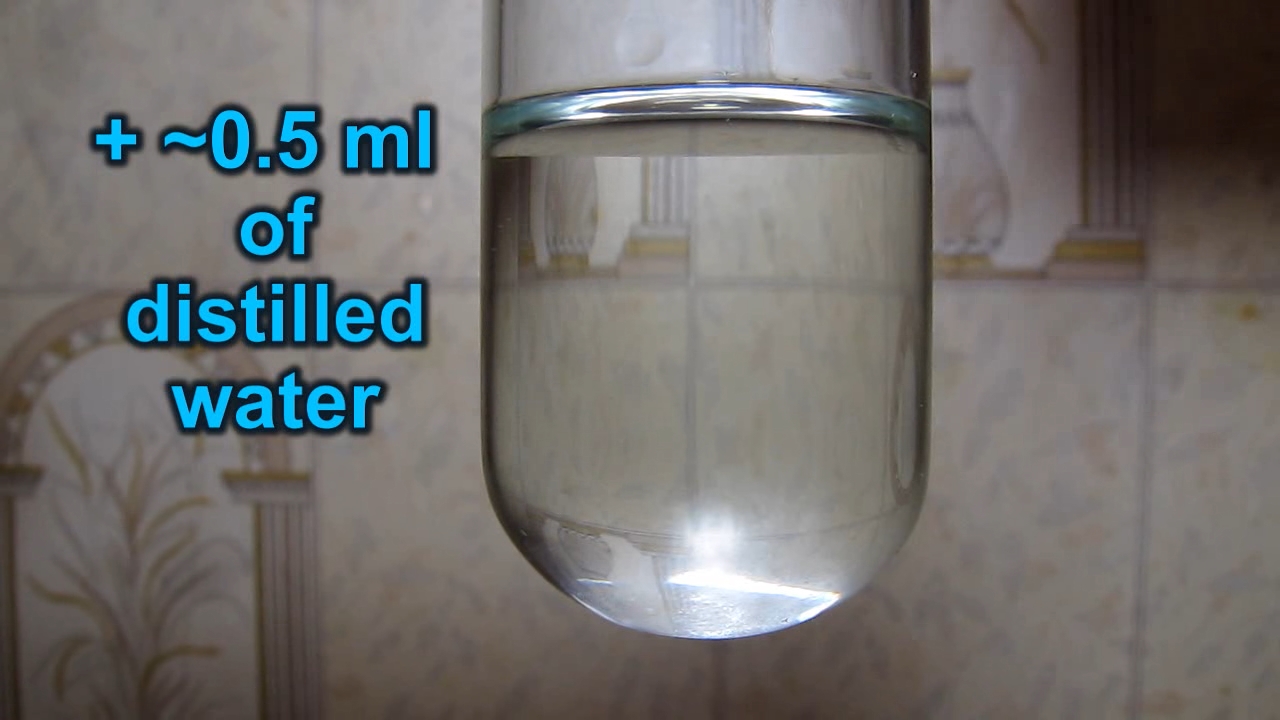
|
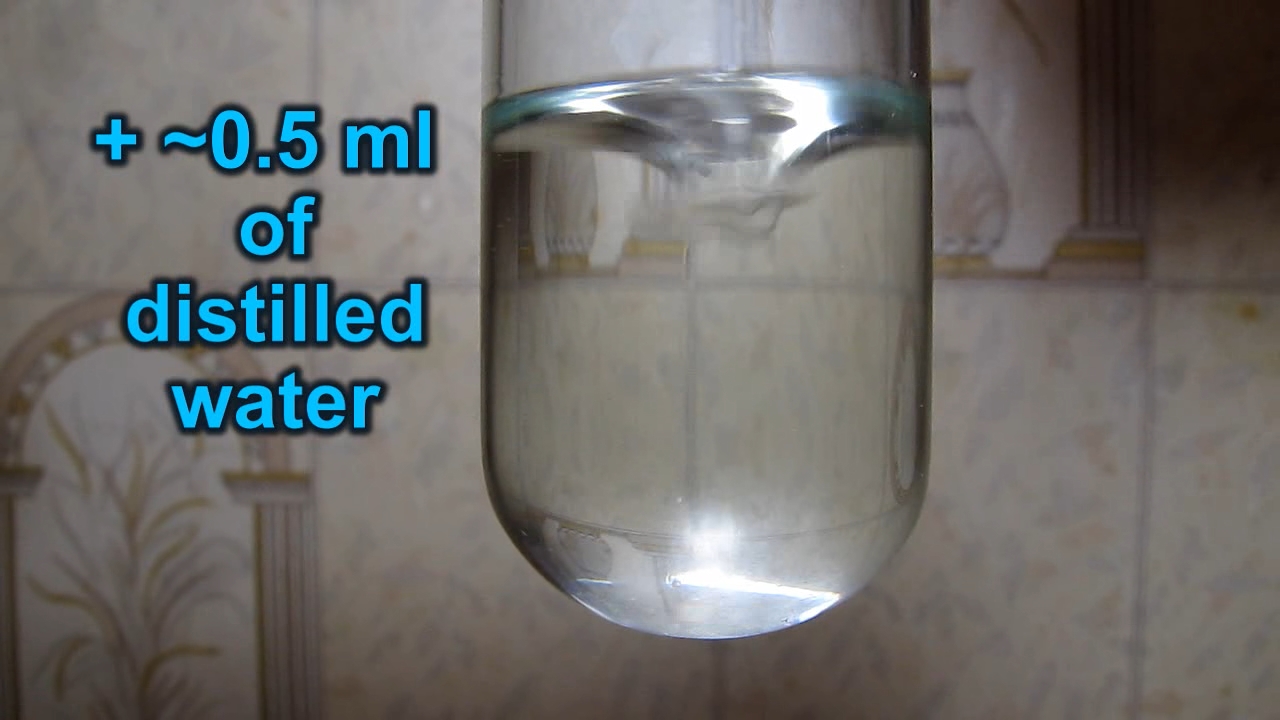
|

|
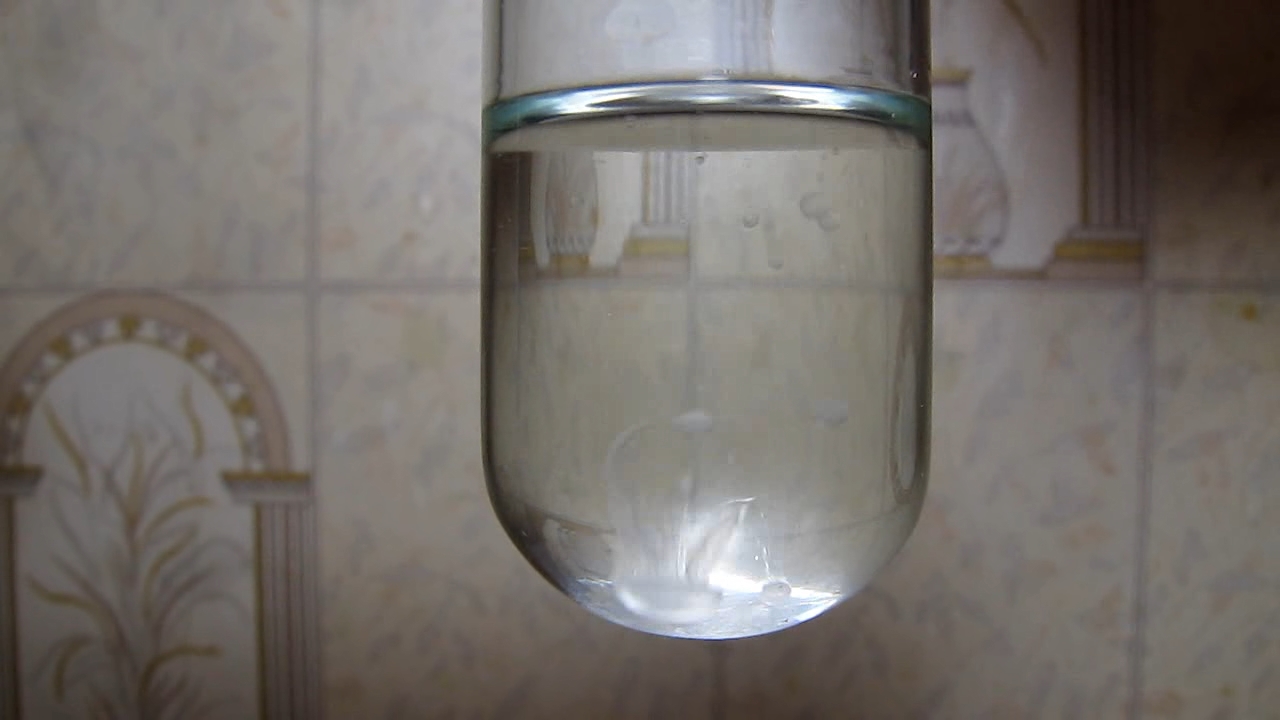
|

|
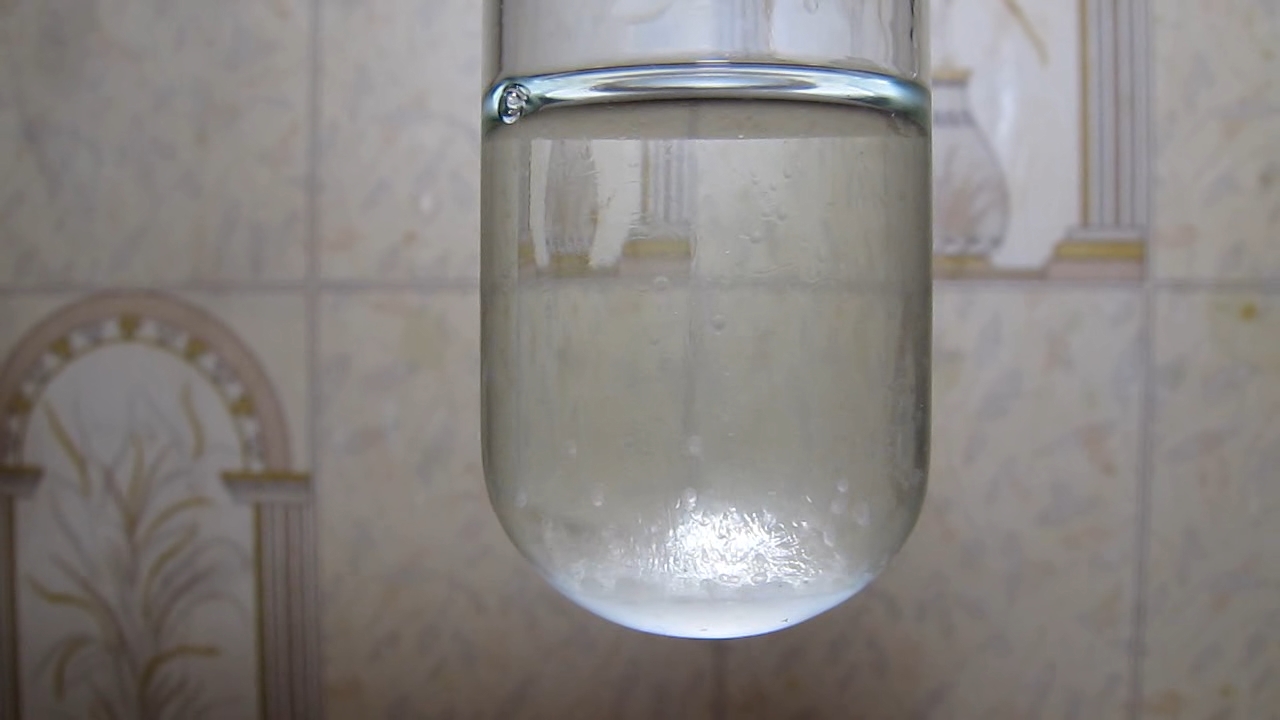
|
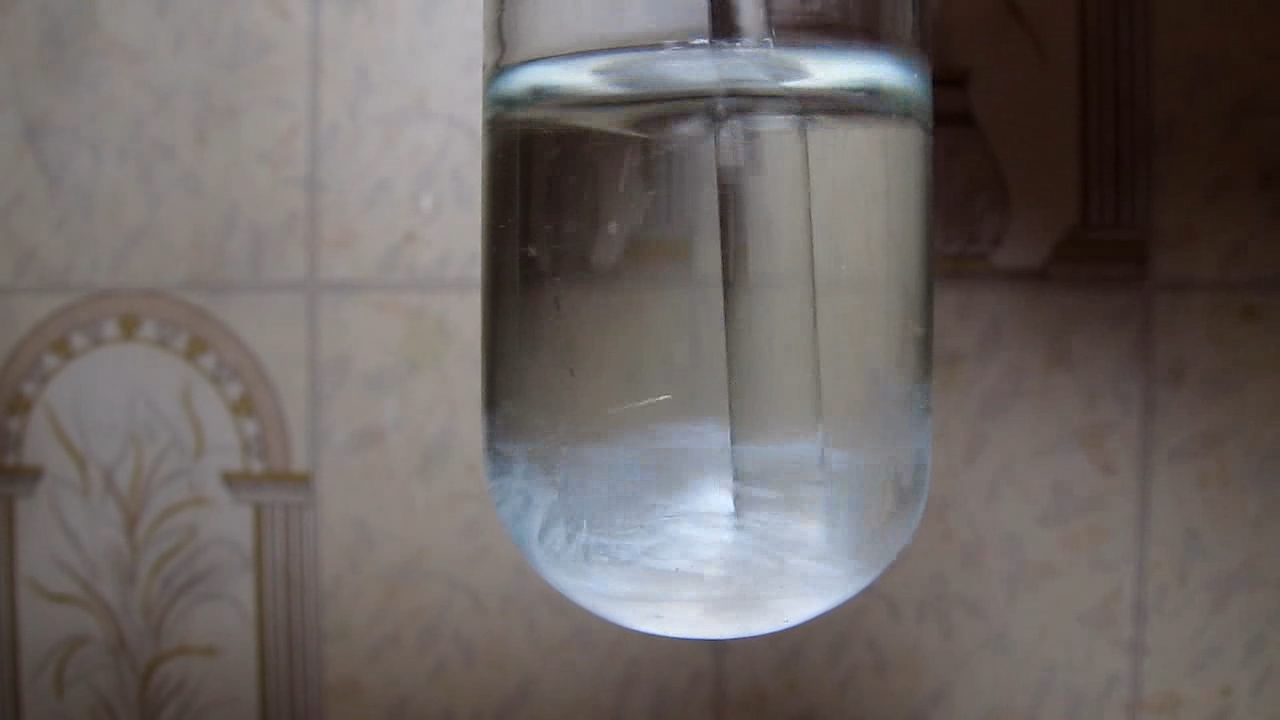
|
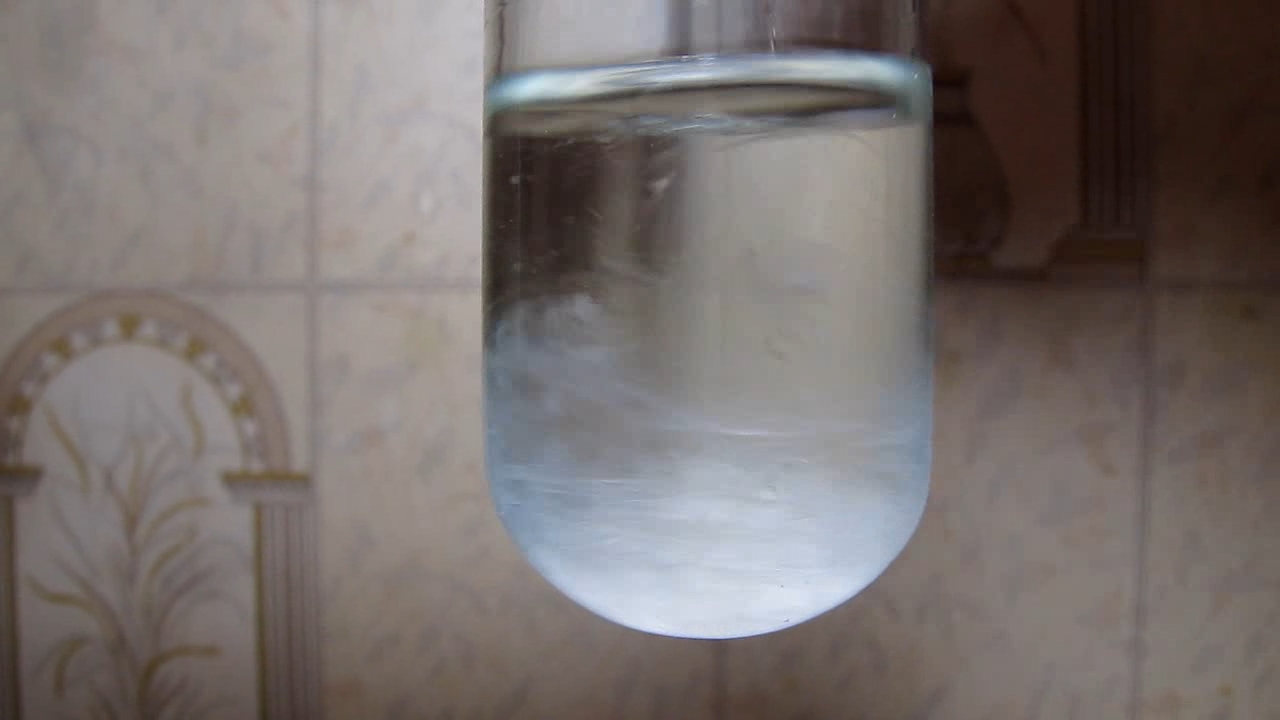
|
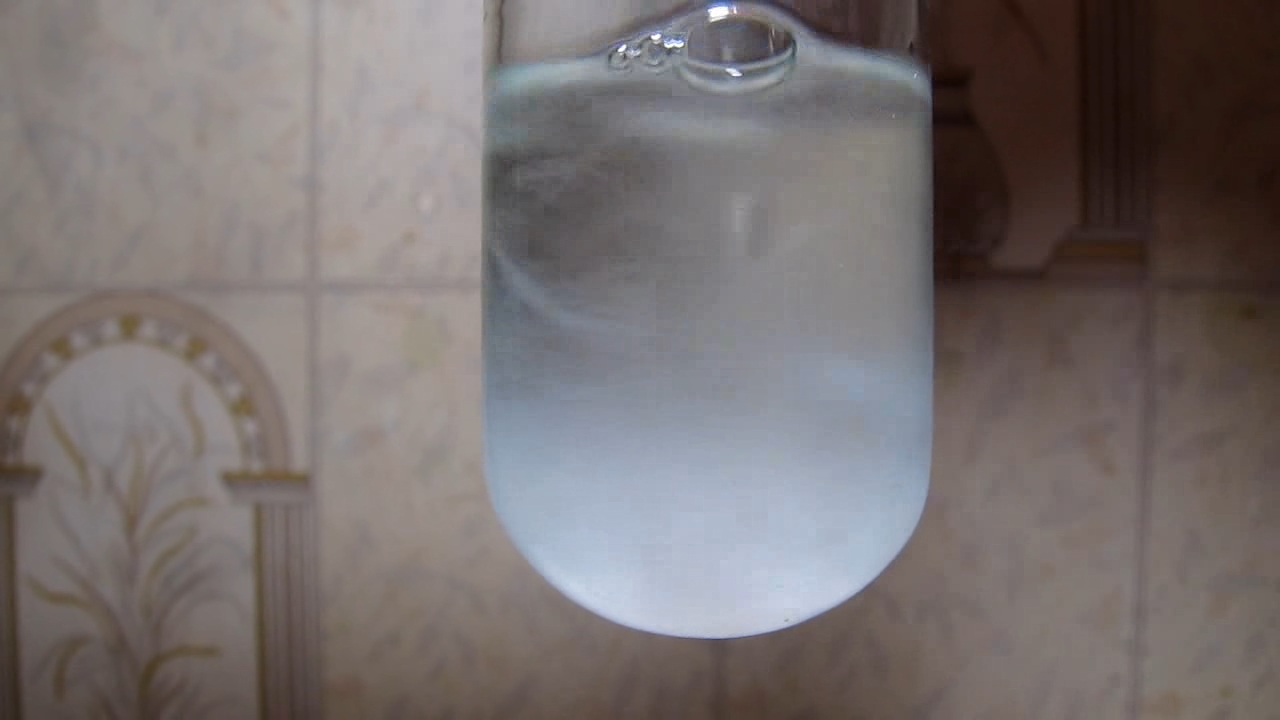
|
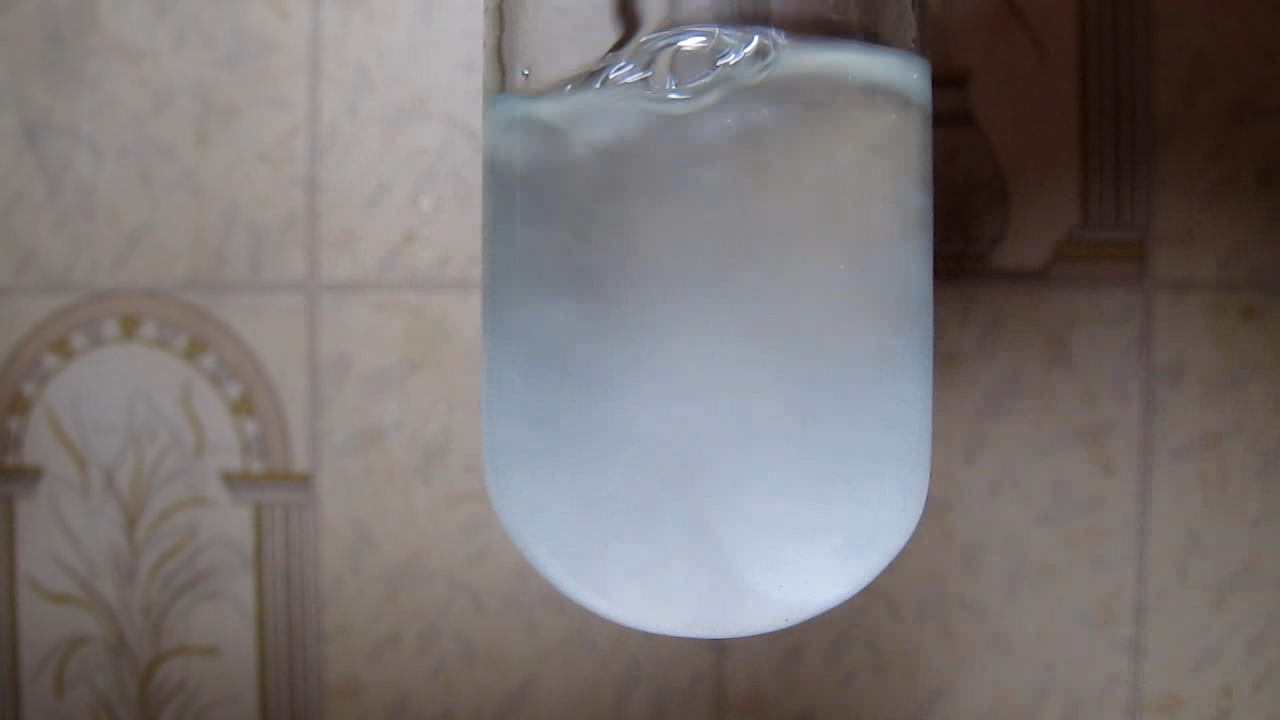
|

|
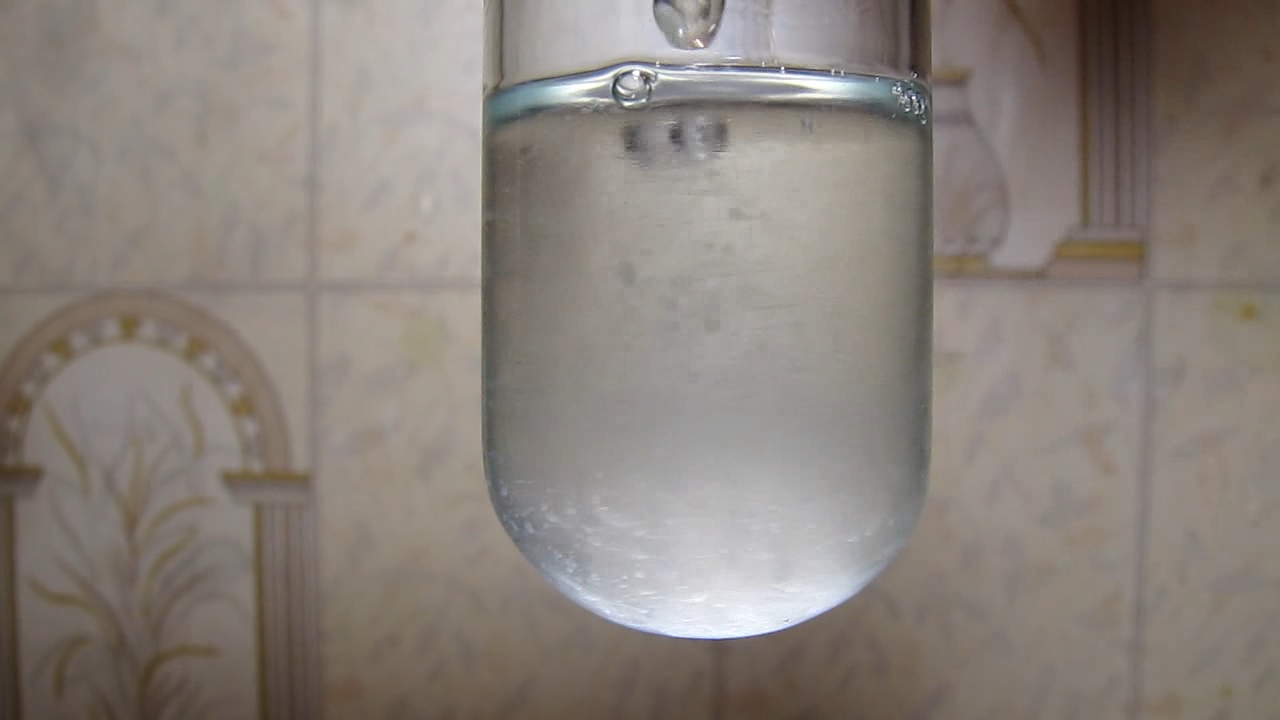
|

|
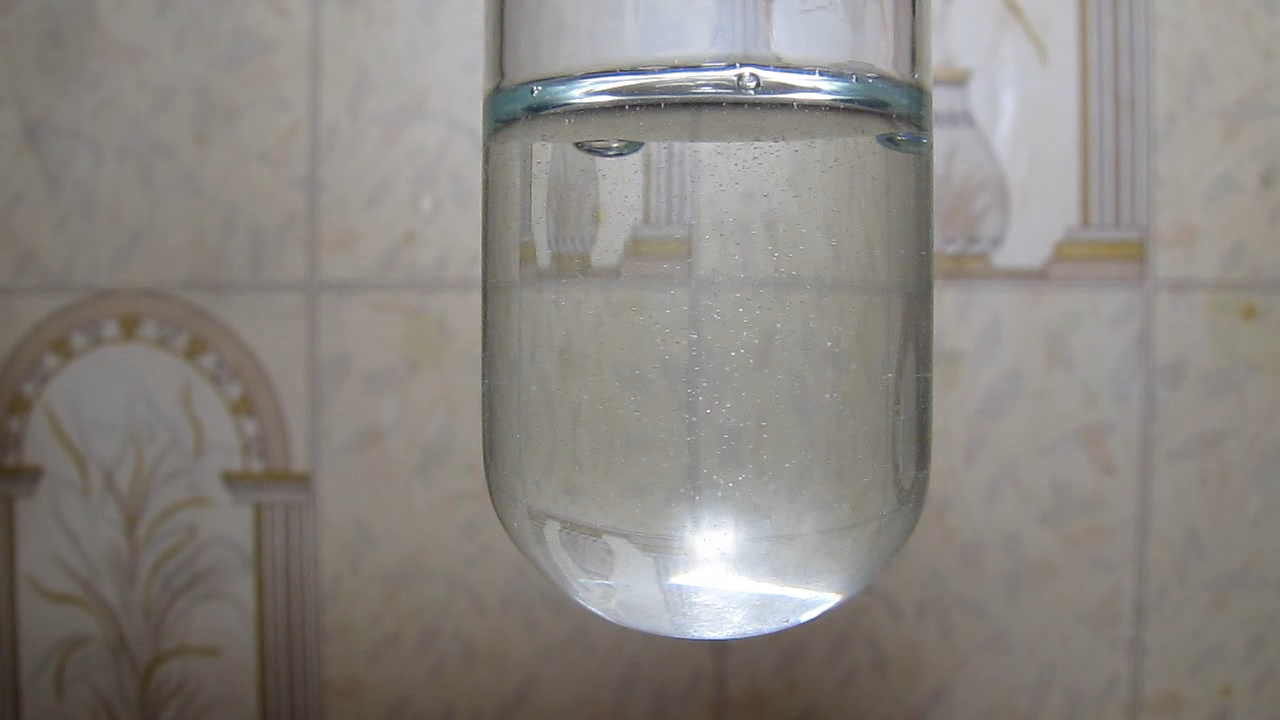
|
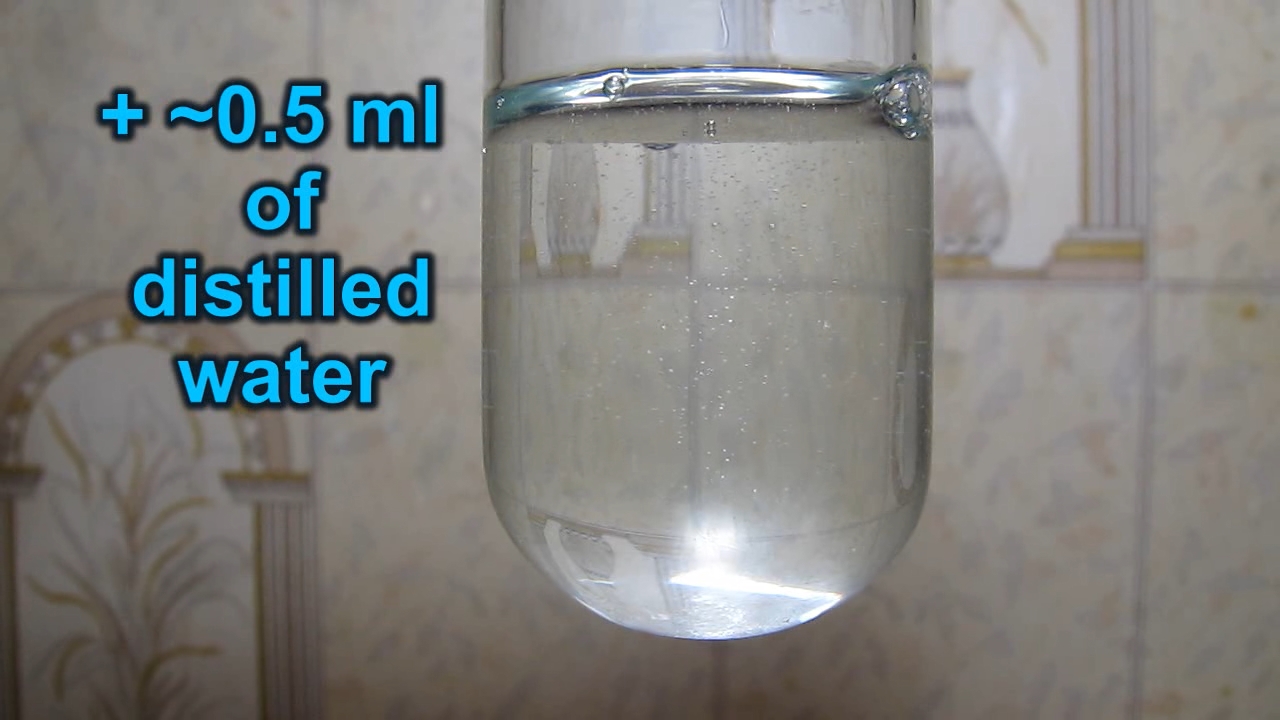
|

|

|
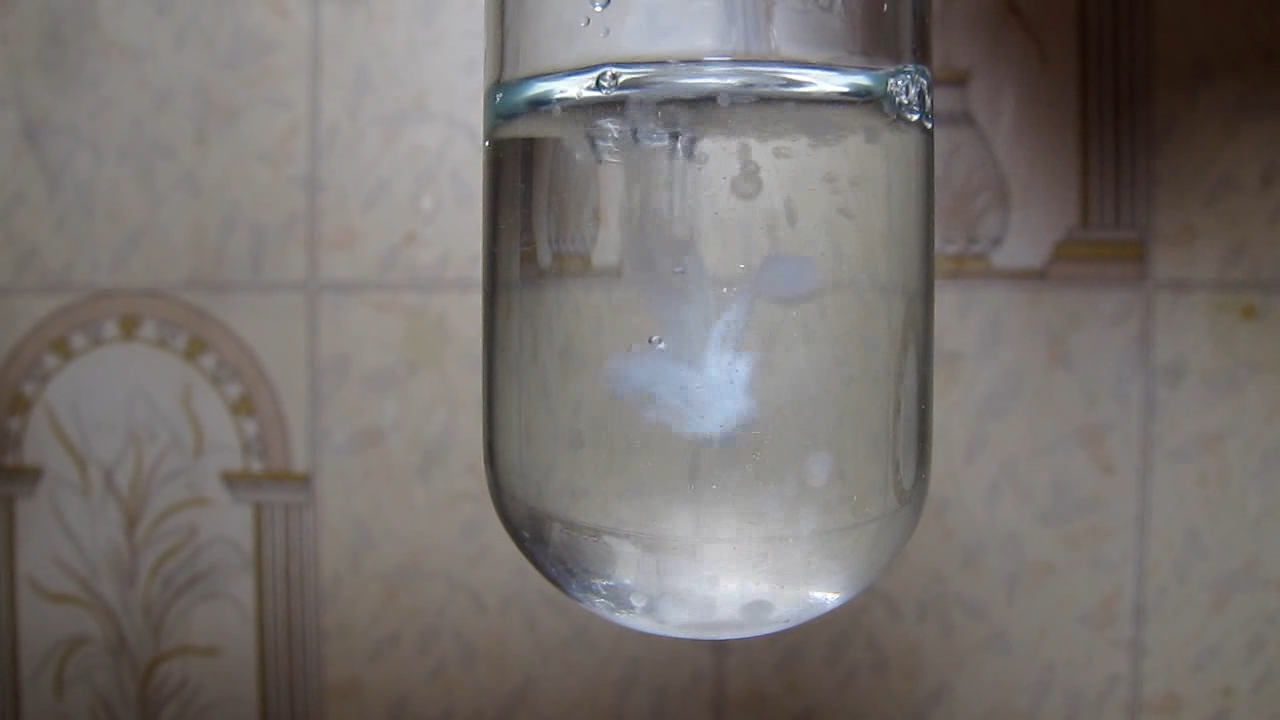
|

|

|

|
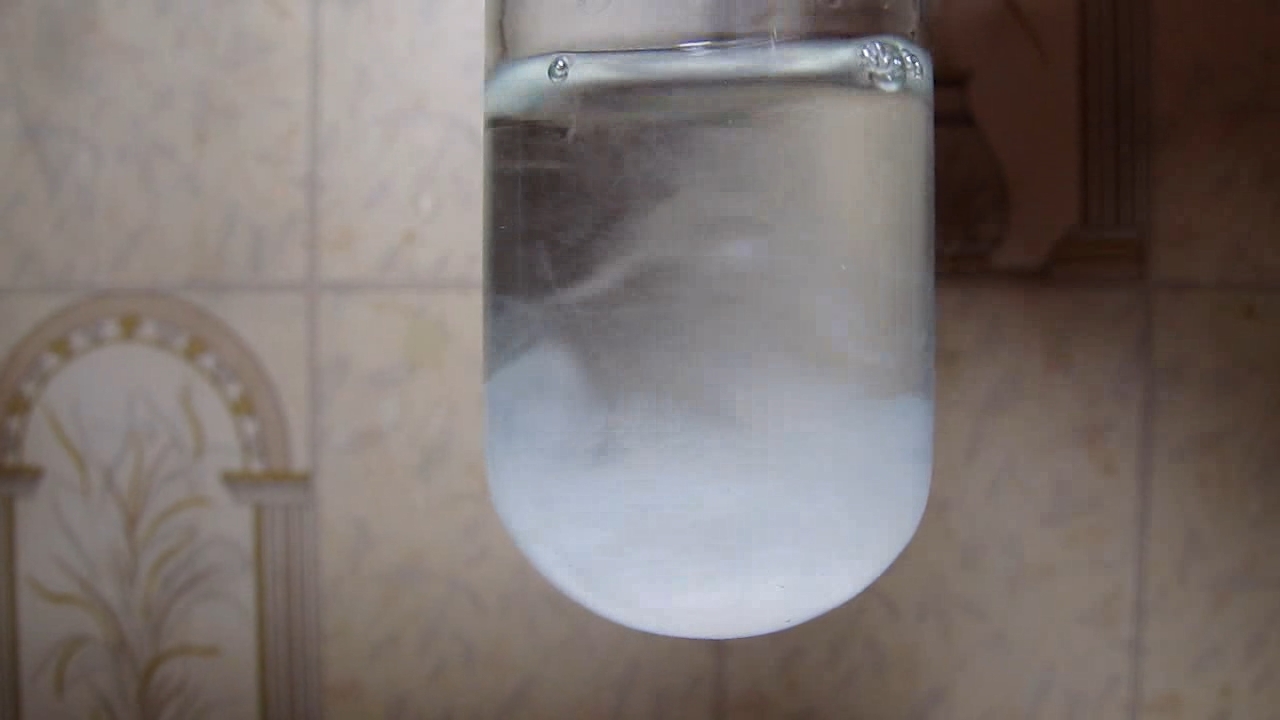
|
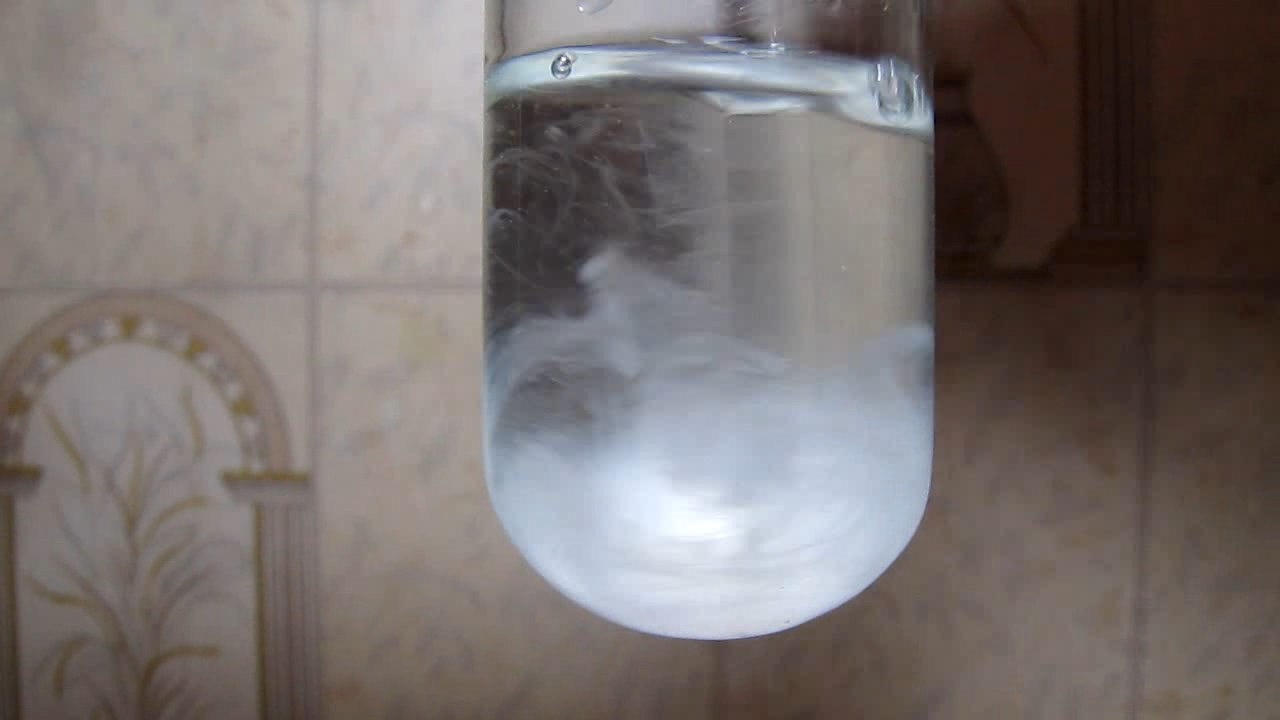
|
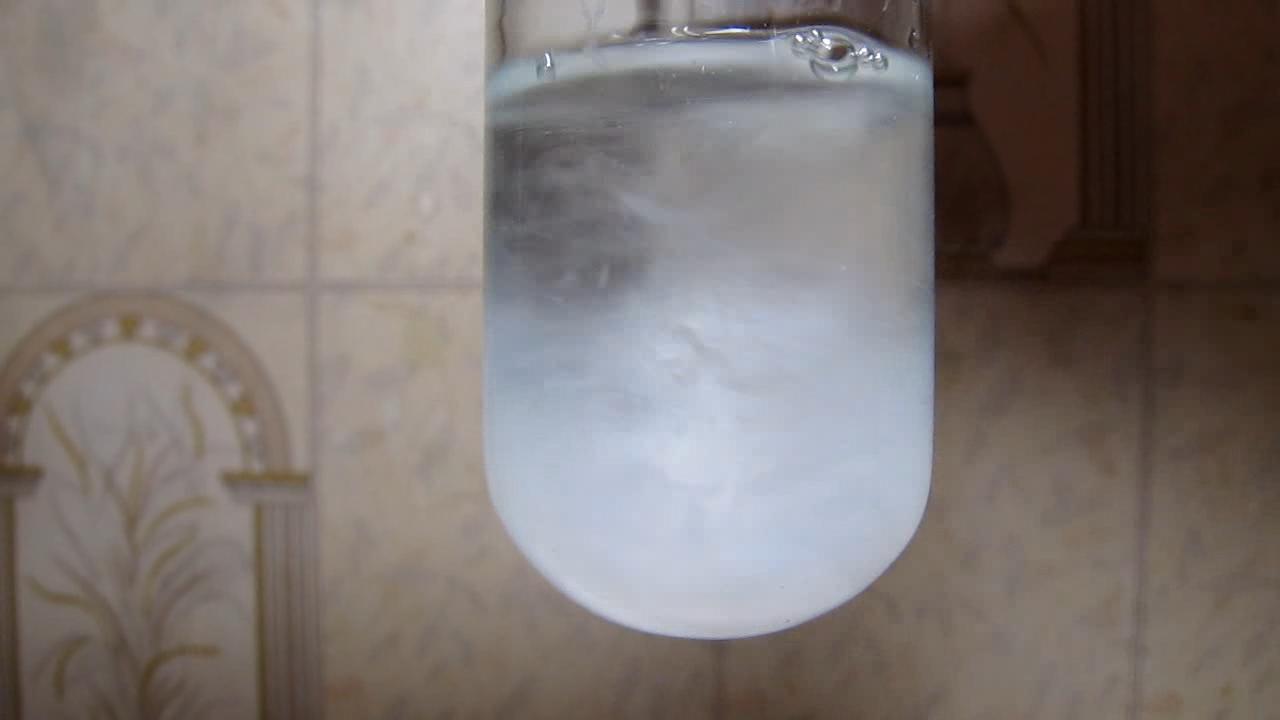
|
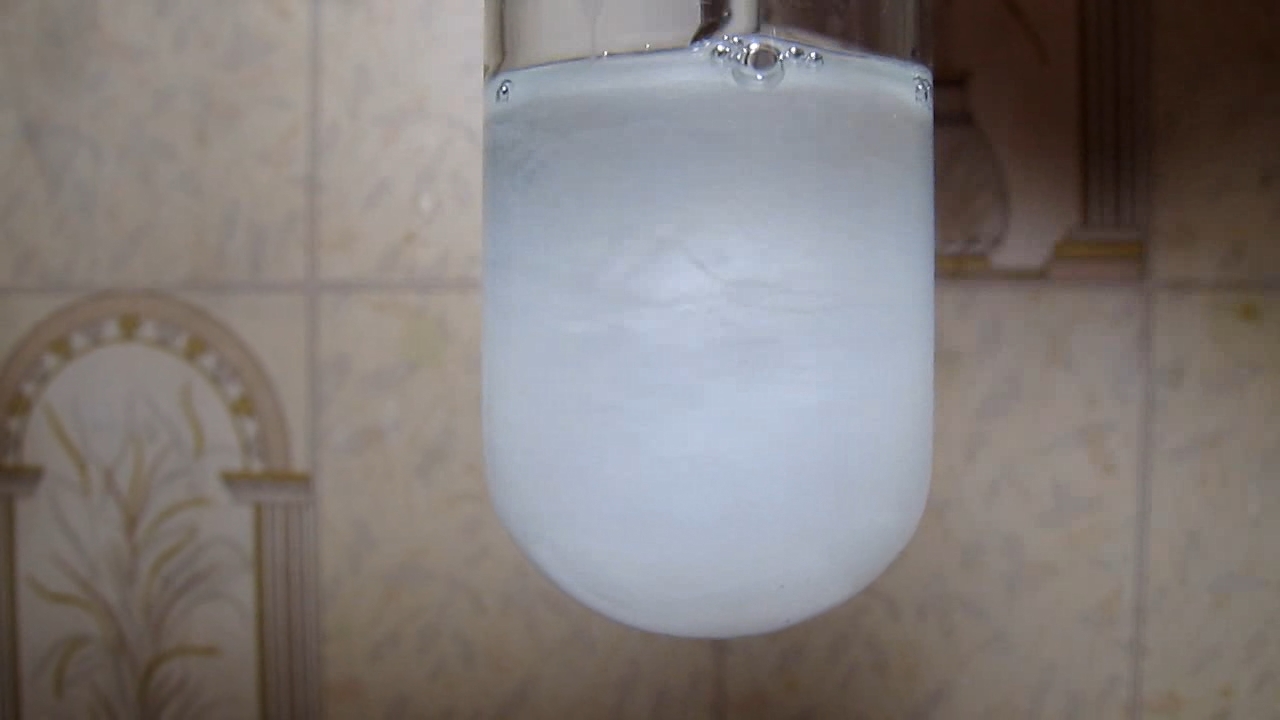
|

|

|

|
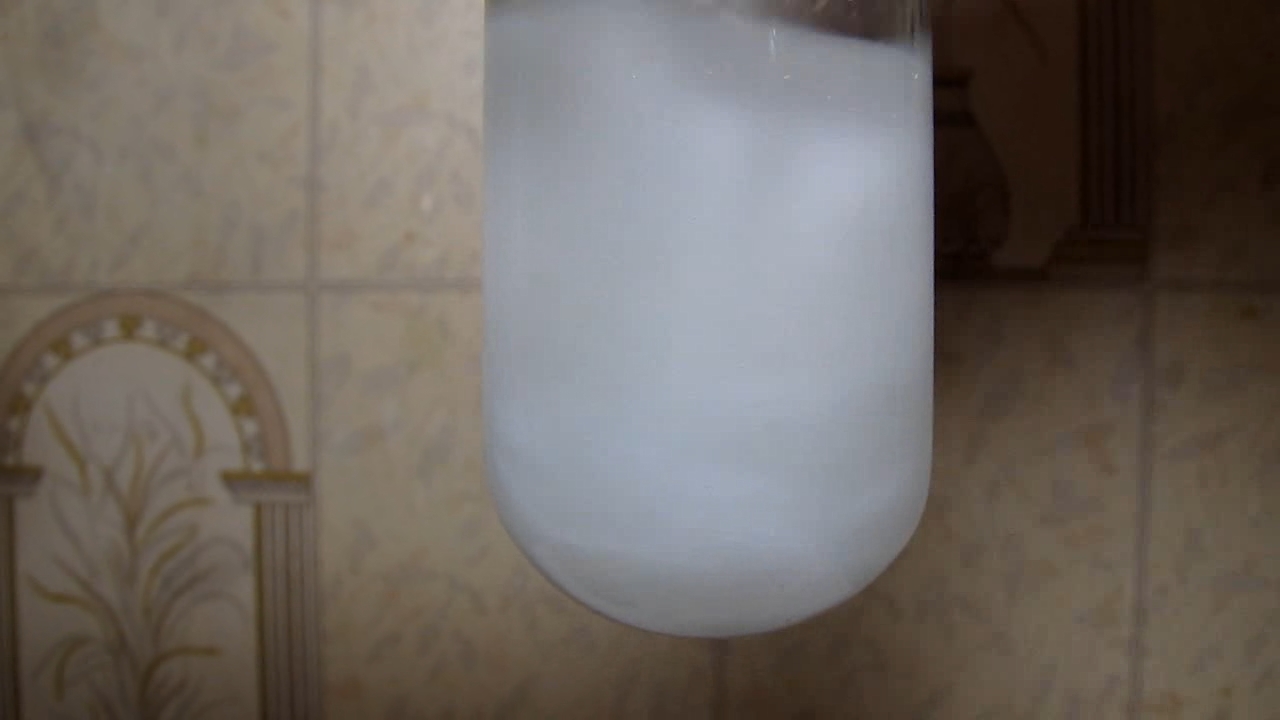
|

|

|
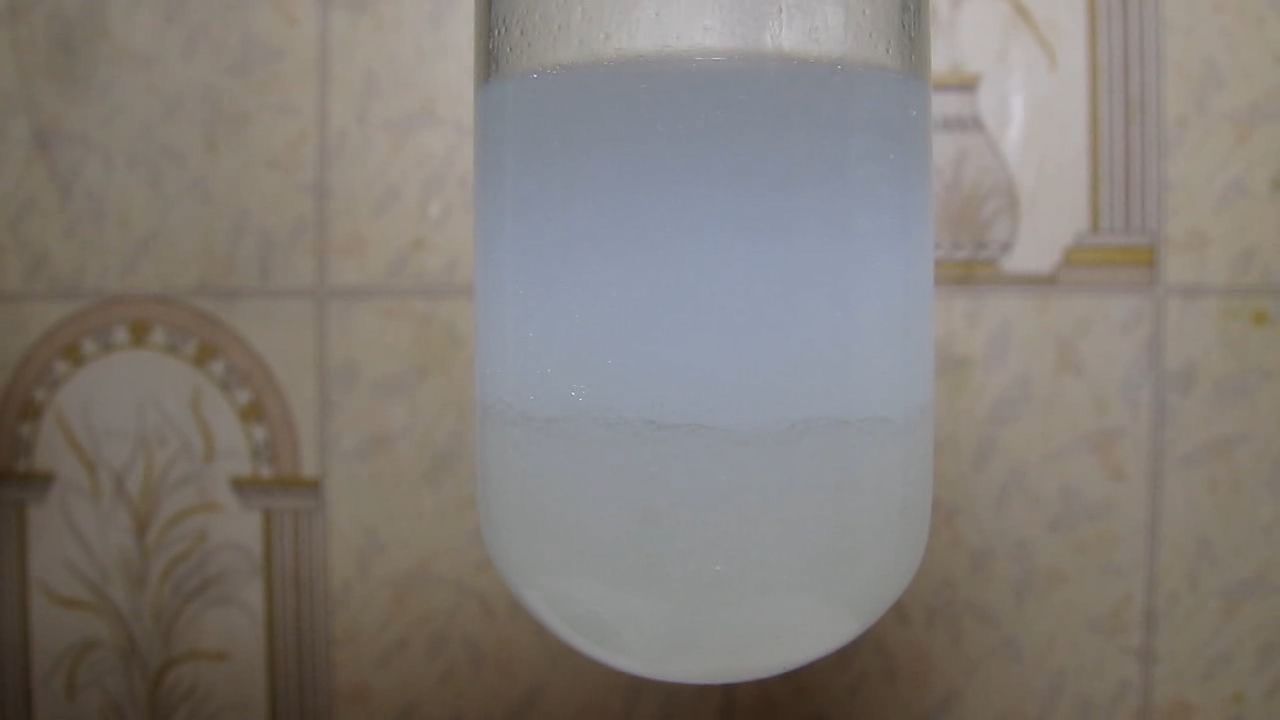
|

|

|
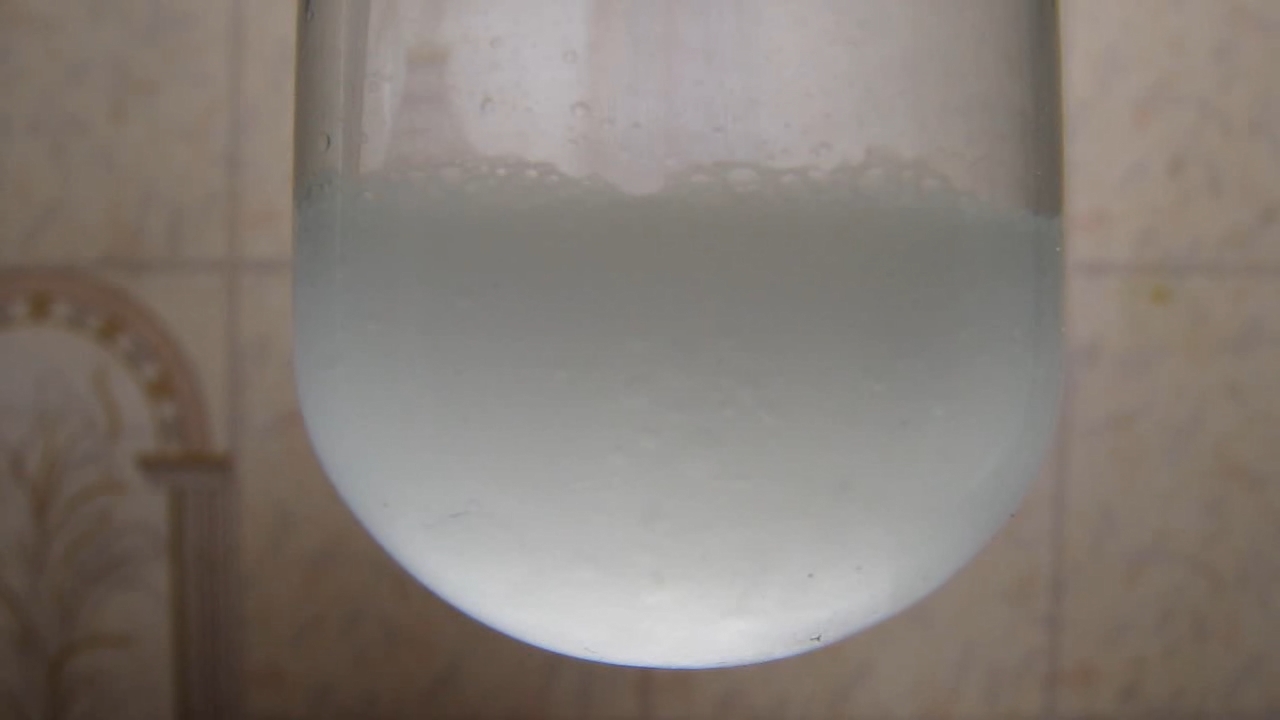
|
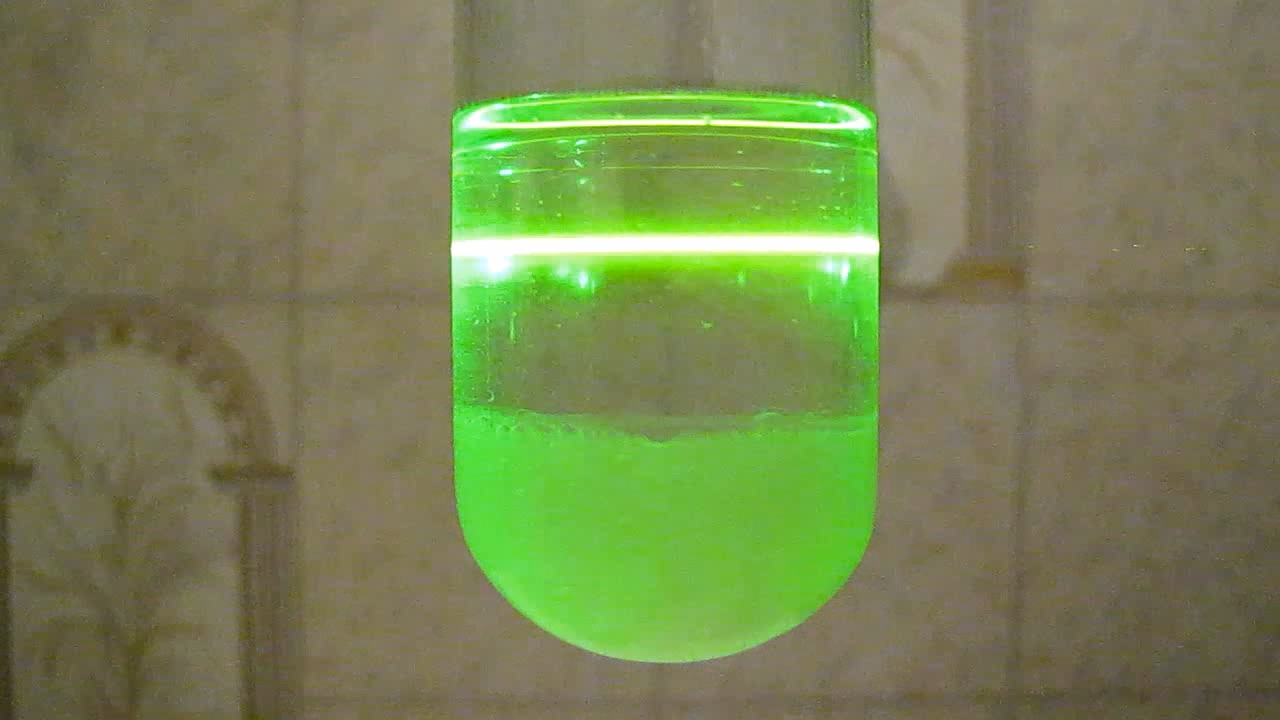
|
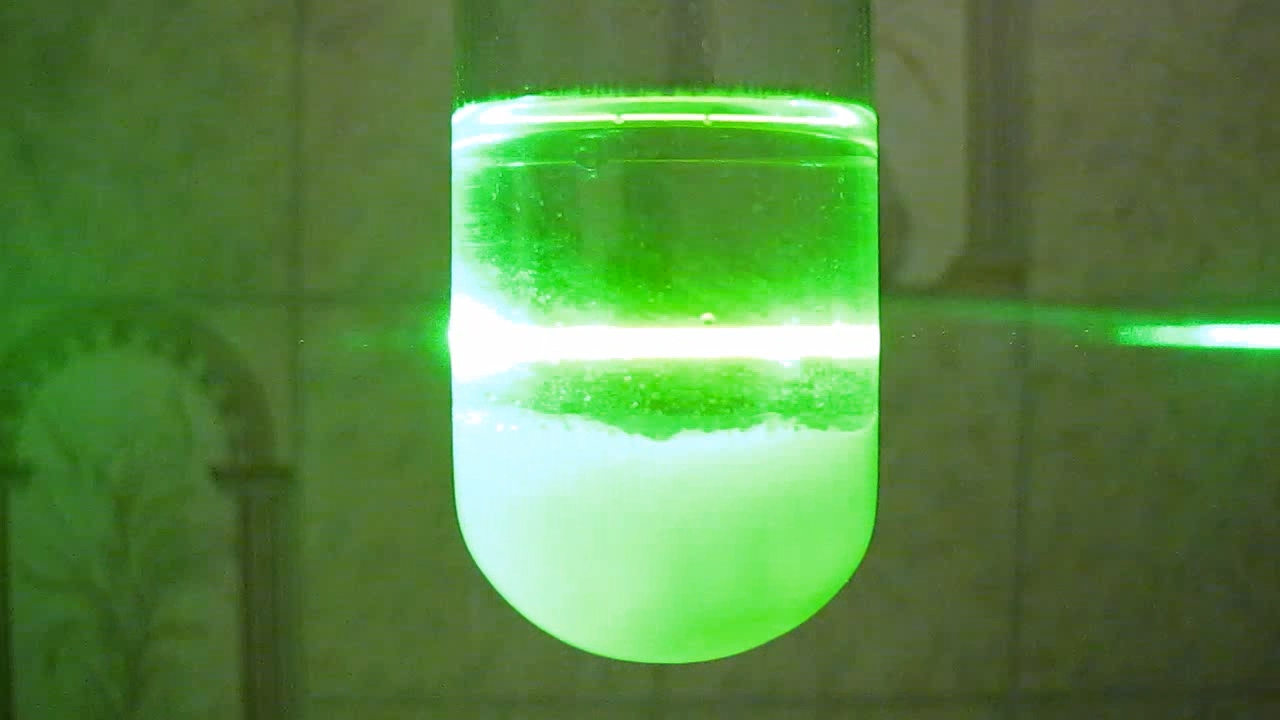
|
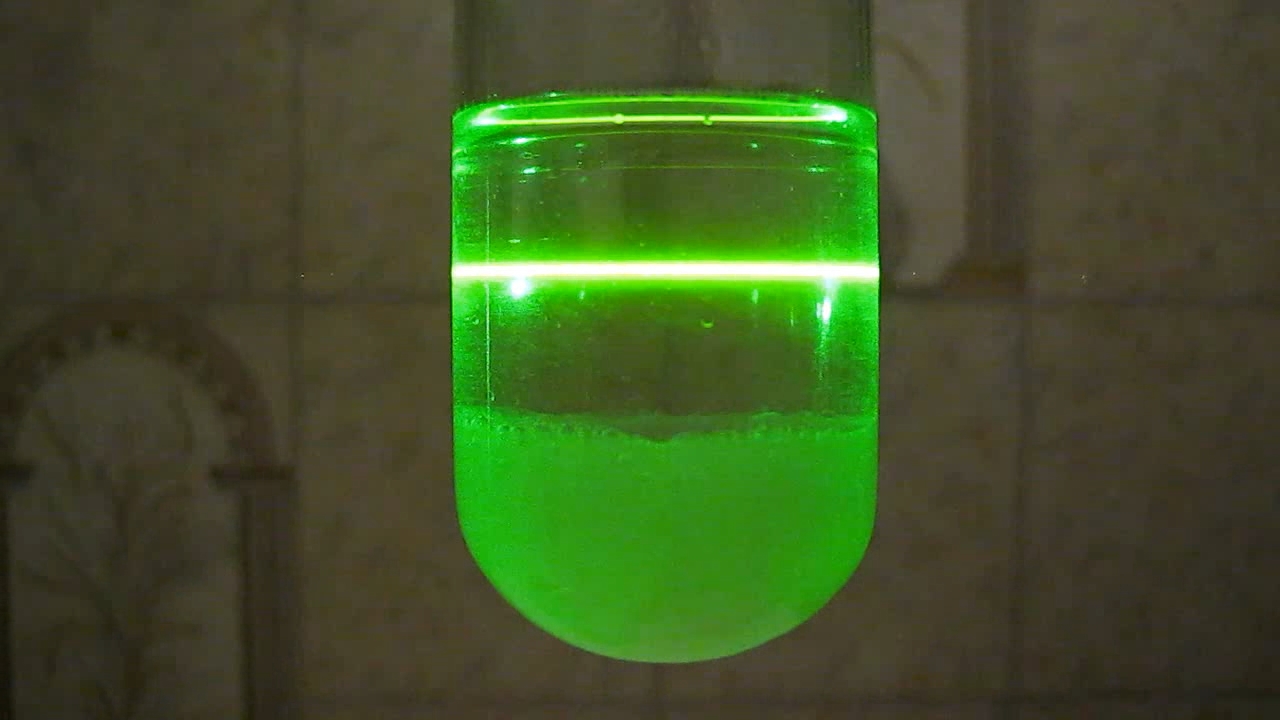
|
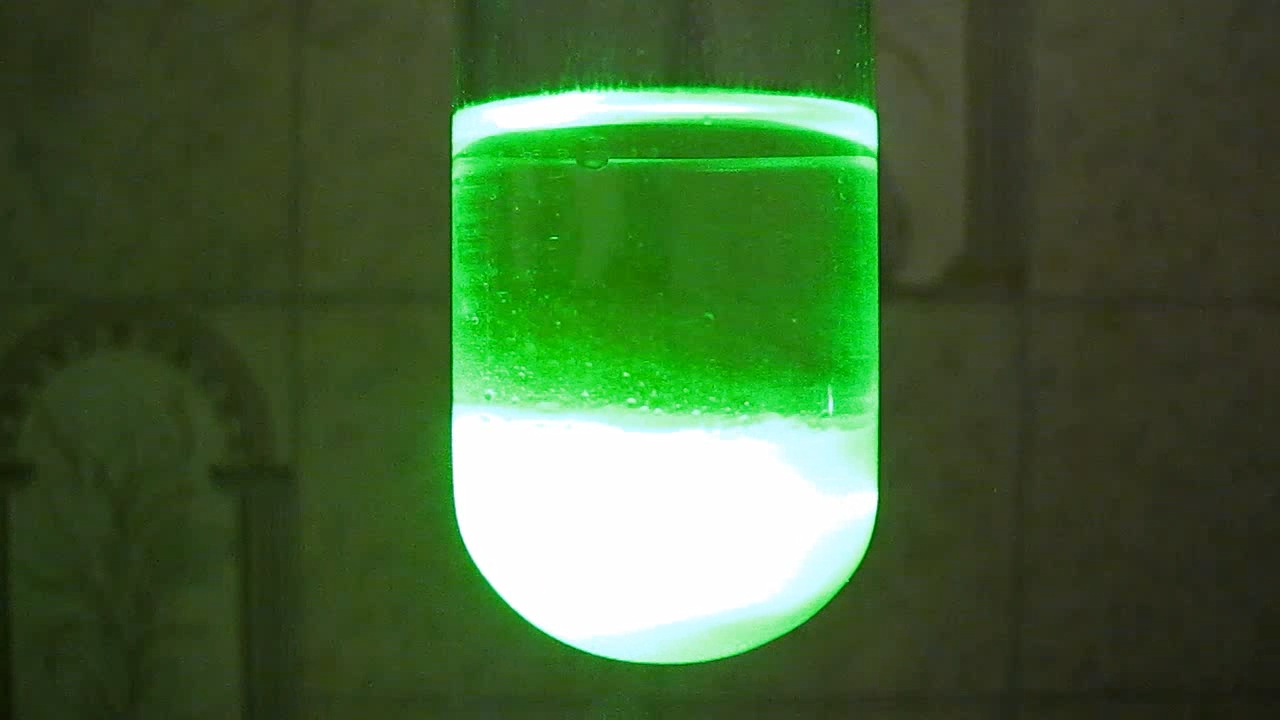
|
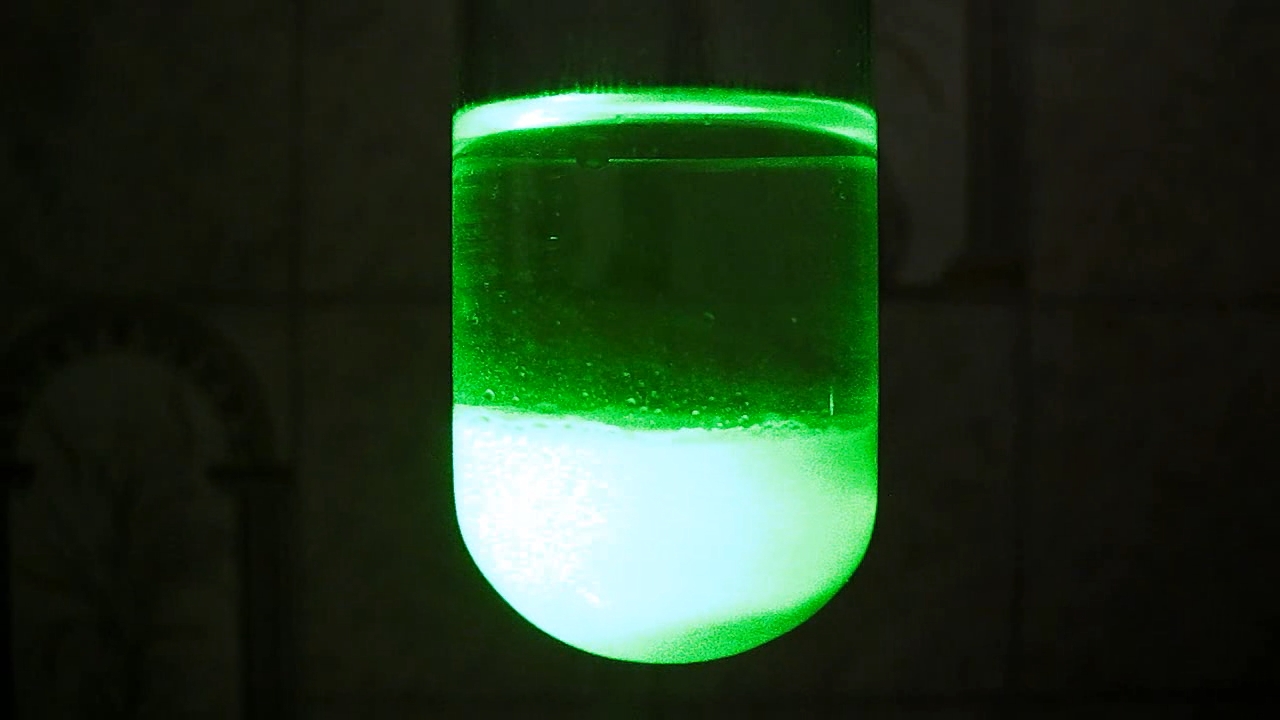
|
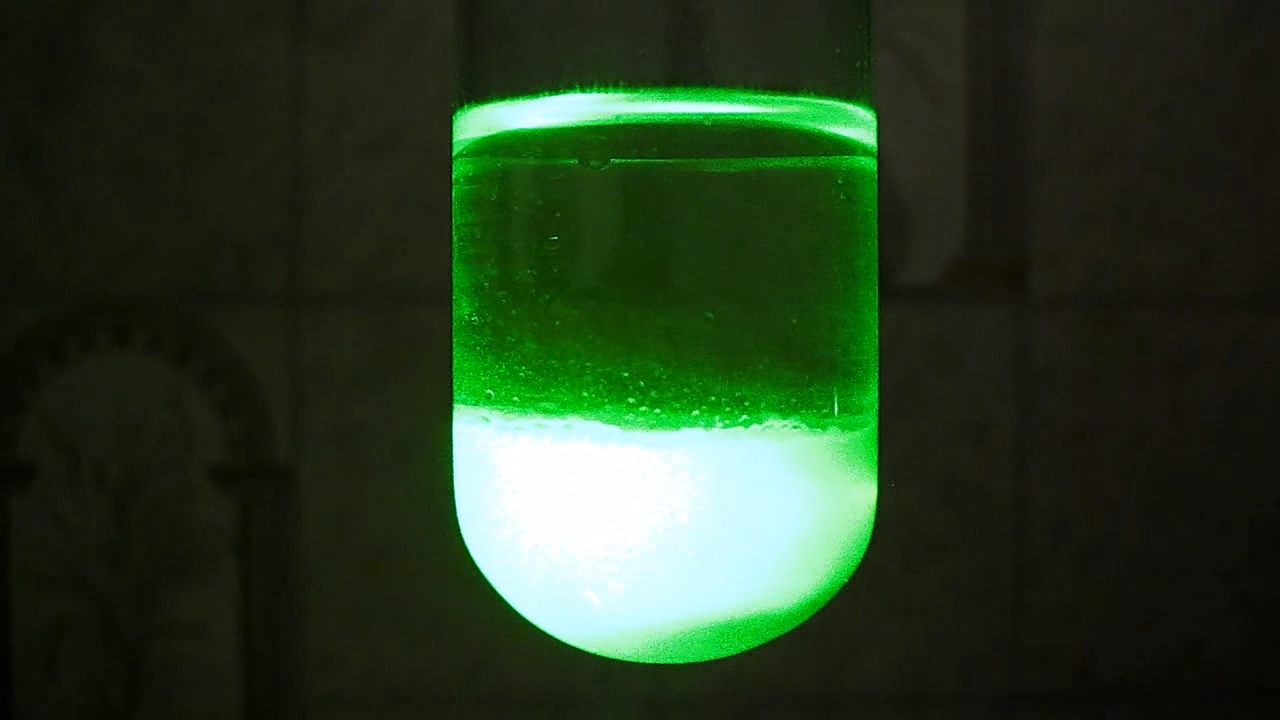
|

|
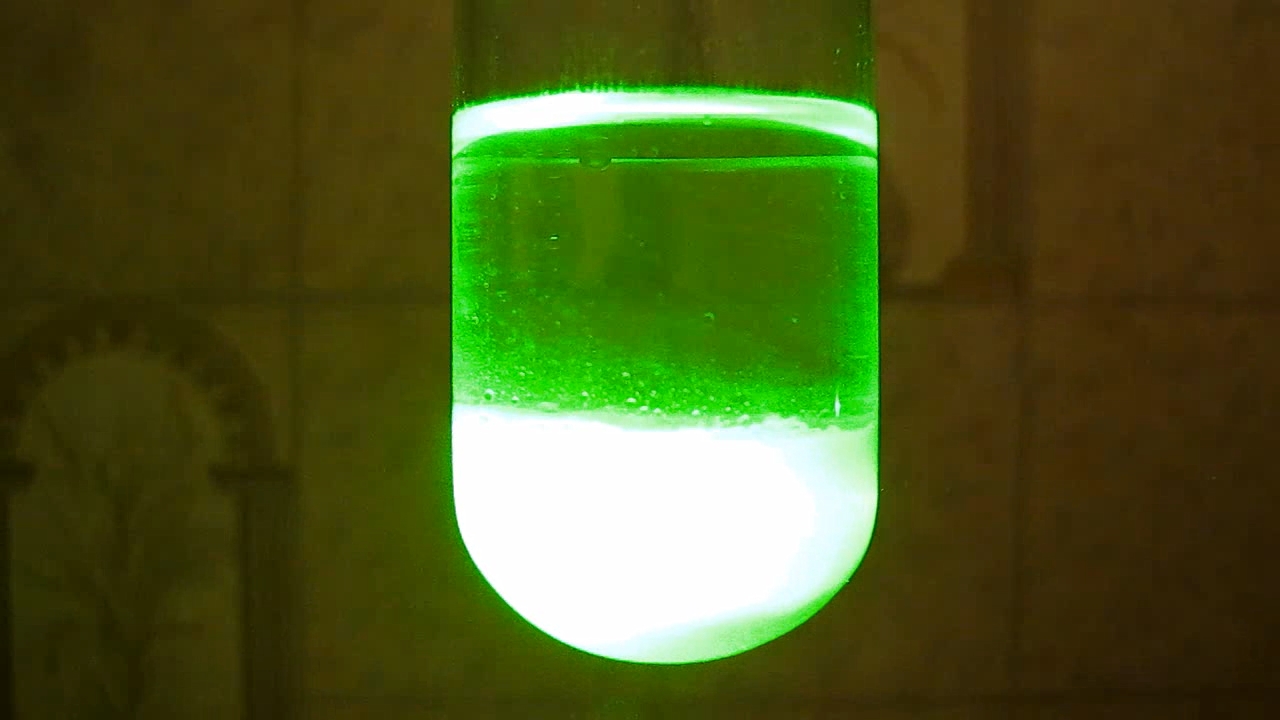
|
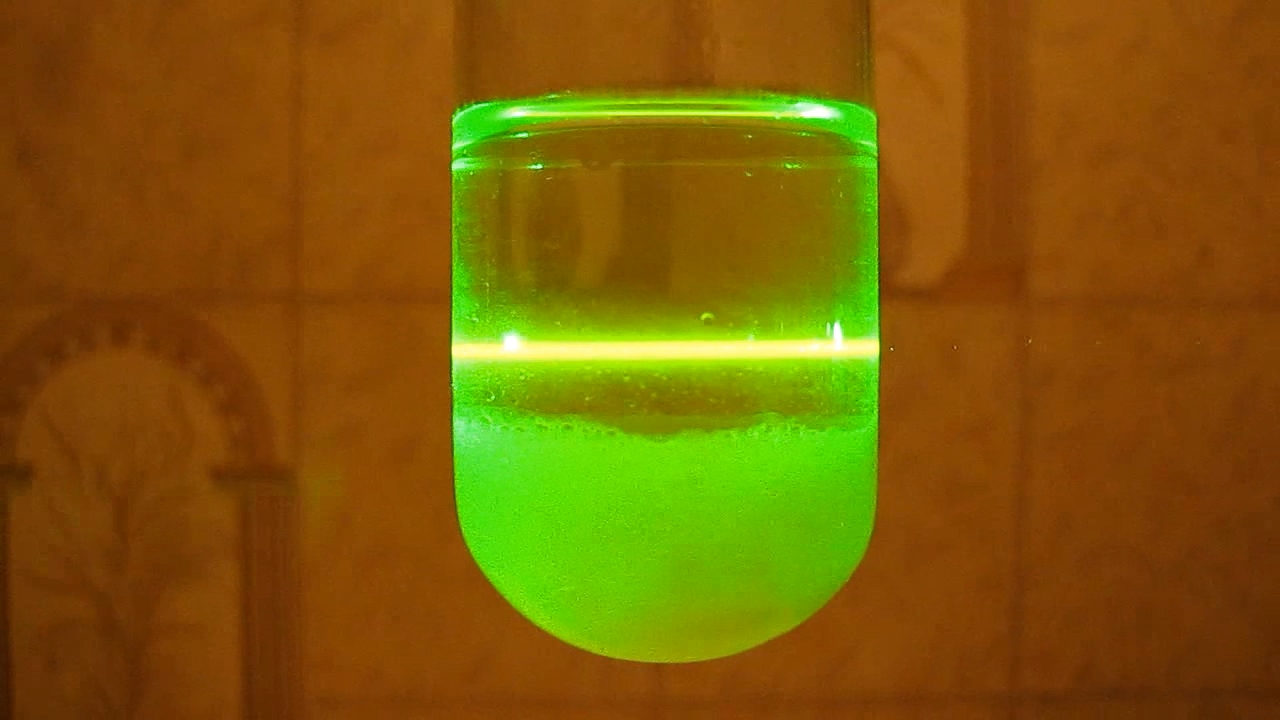
|
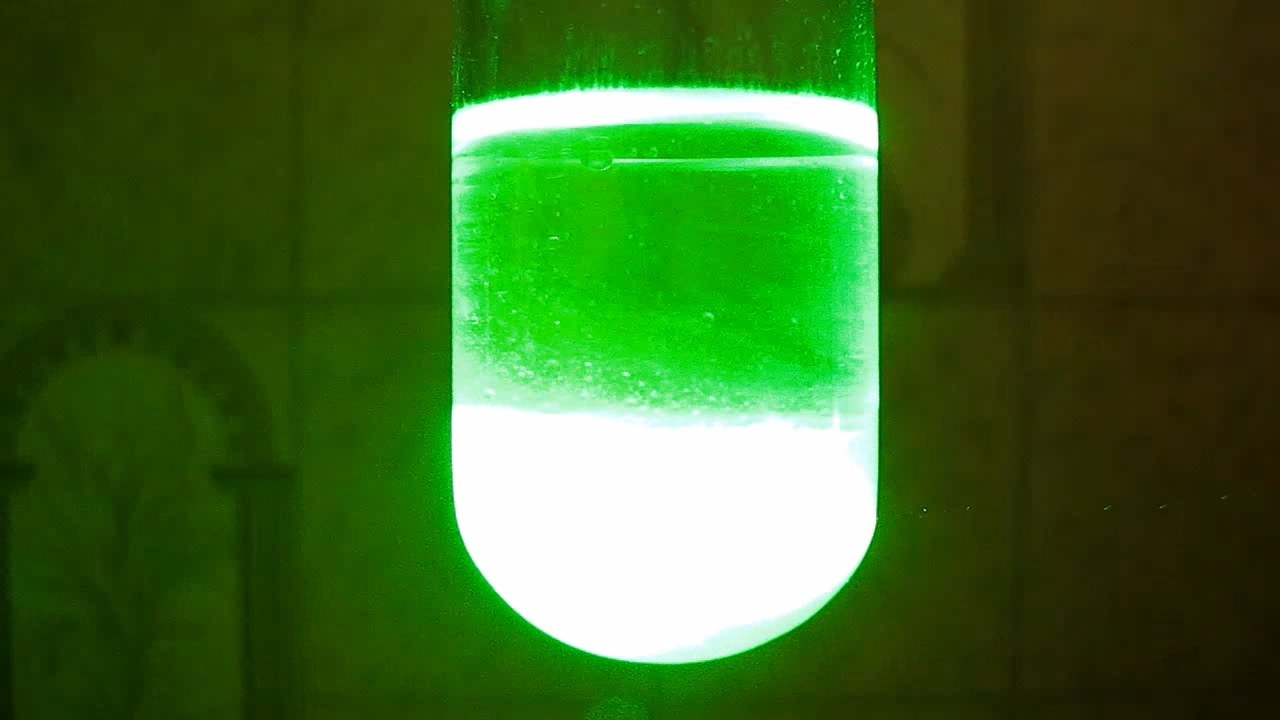
|

|

|

|
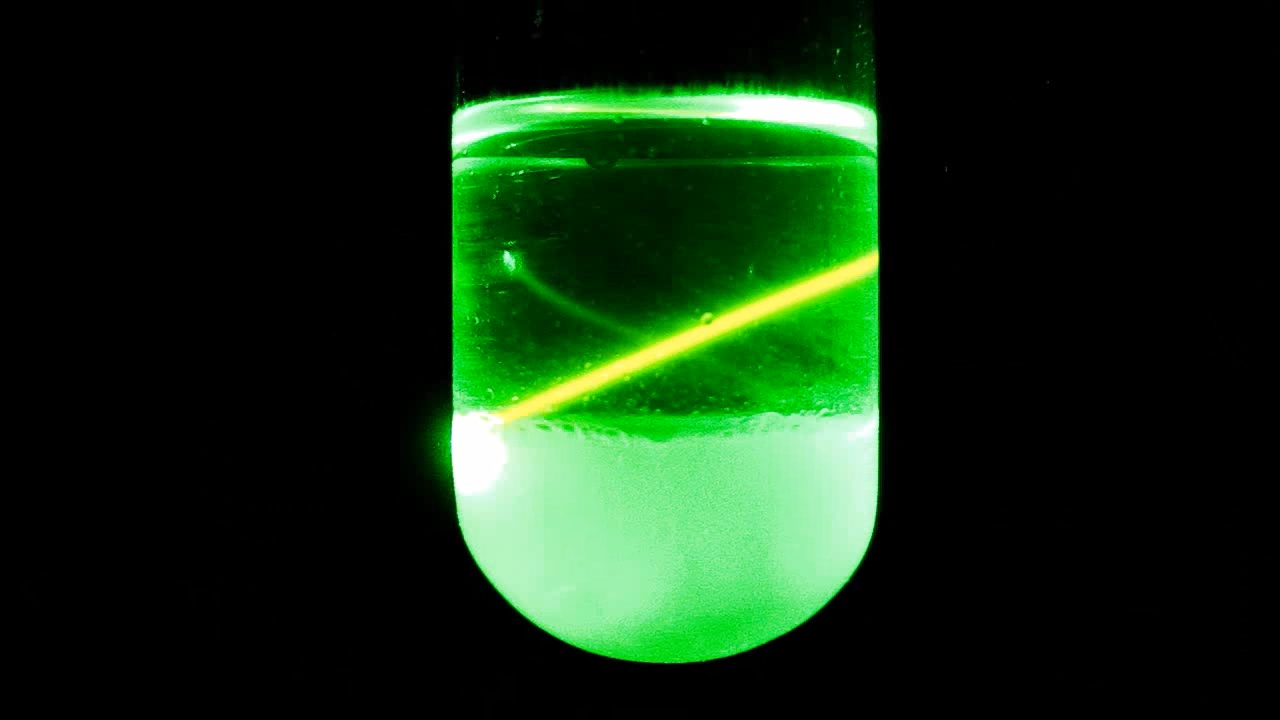
|
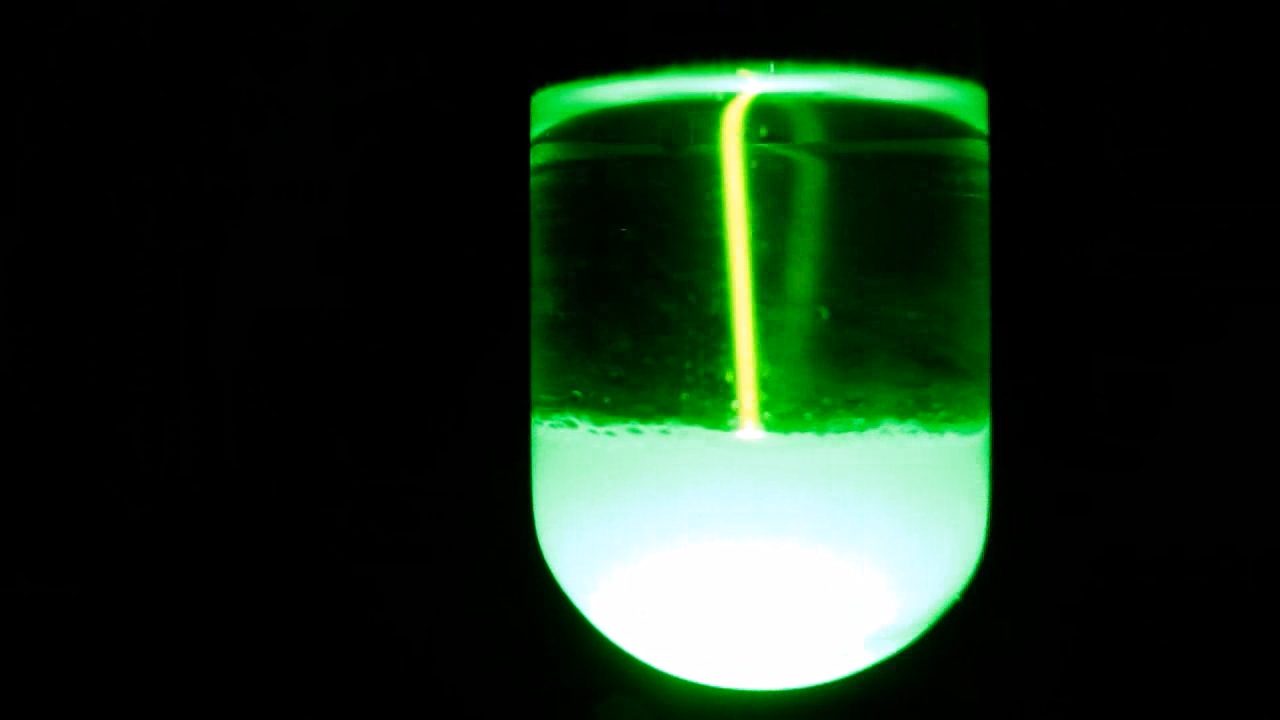
|

|
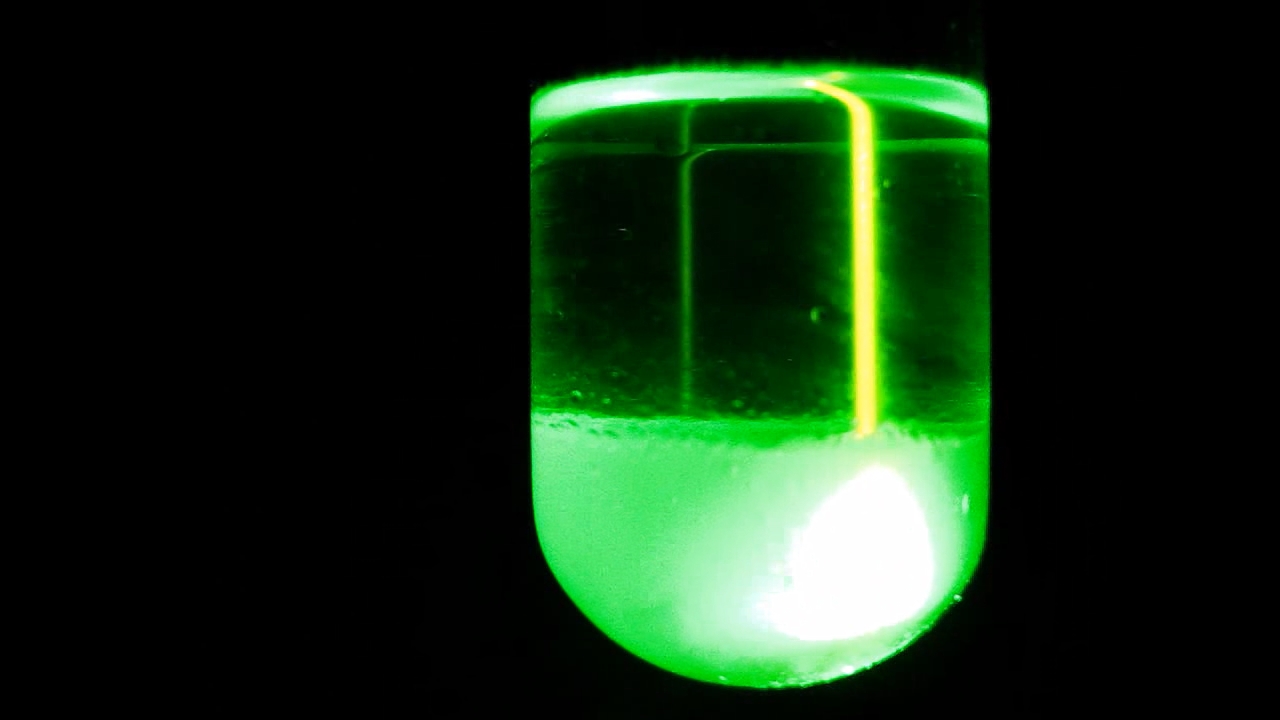
|

|
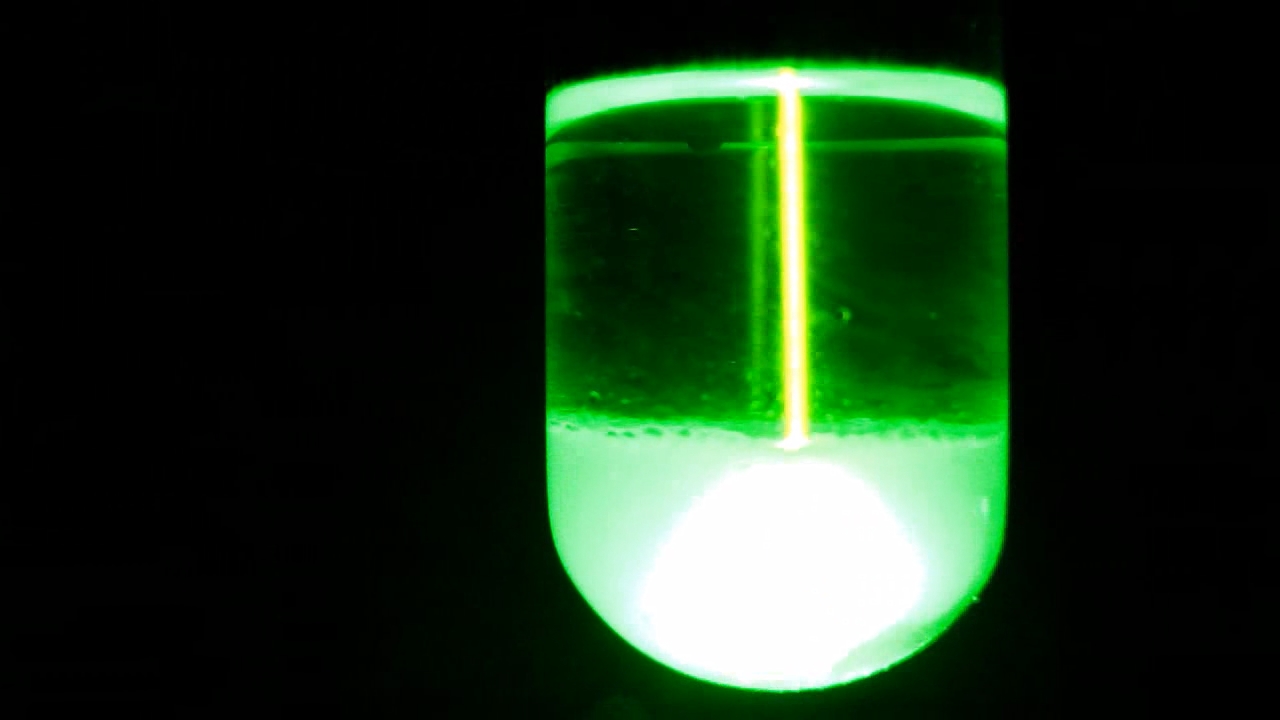
|
|
Комментарии
К1
Можно получить раствор фенола в воде. Или раствор воды в феноле. Однако, это не значит, что вода с фенолом смешиваются в любых пропорциях. Даже выше точки плавления фенола.
К1-1 Существует два случая: *две жидкости полностью смешиваются (неограниченная взаимная растворимость); * две жидкости частично смешиваются, когда в бинарной системе образуются два раствора (А в В и В в А). Причем одновременно может существовать, как один из них, так и сразу оба. Две "полностью несмешивающийся" жидкости, это, по сути, частный случай второго варианта, когда взаимная растворимость крайне низкая. |